|
A truly rare event for me as a photographer and videographer occurred this past weekend in Puget Sound. For many years I have been fortunate enough to spot only a few Cockscomb fish. The High Cockscomb and Slender Cockscomb are members of the Prickleback family. And although they may appear similar to an eel, they are not eels. Below are images of Snake Pricklebacks taken over the years. This time of year, our local waters suffer repeated weather events that degrade the visibility and clarity of the water. Rains can infuse fresh water from the surface down to well over 30 feet in some areas. Rain washes down massive collections of pollutants and toxins that accumulate on our roads, highways, bridges, driveways, yards and more. These toxins drain directly into our streams, rivers, lakes, and eventually Puget Sound. Also, longer days with increased sunlight generate considerable Algae blooms. At times, visibility can be reduced to less than 12” from the surface to more than eighty feet deep. Light is unable to penetrate the particulate matter, or backscatter. There are times on a bright sunny day, at mid-day during summer, it can be so dark that many nocturnal animals will come out to hunt their prey.
The past month the visibility within Puget Sound has been unseasonably poor due to the few weeks of very sunny days. Fortunately, even during these recent poor diving conditions, I was able to enjoy a couple very rare minutes with a Slender Cockscomb. View my new 4K video of my brief encounter: Slender Cockscomb
0 Comments
2021 is promising to be a far better year than the last challenging Covid year of hibernation. Things are looking up all around and we’re beginning to reclaim a modicum of normalcy in our lives. During these first few months of 2021 I’ve been working at learning many of the amazing features of the new Canon R5 mirror less camera. A truly amazing camera with some features I may never need, but it's nice they're there. For instance, although 8K video is possible, at this point in time it's not totally viable. The 4K performance on the other hand is stunning. Wether recording at 23.98, 30, 60, or 120 fps (excellent slow-motion video), this camera is truly cutting edge technology. Challenges in developing an effective and efficient workflow has taken much more time and effort, and trial and error than I anticipated. Shooting steady and smooth 4K video, then downloading, trimming and storing extremely large file sizes is merely the tip of this very large iceberg. Color grading, LUT’s, proxy files, Codecs, BT 709 or BT 2020, Rec 2021 all can get rather confusing, rather quickly. Each impacts the final video production and quality. I do admit though, it's been a fabulous challenge. This weekend I'm launching a few short videos shot in 4K, mostly shot in slow-motion. Each can now be viewed on my website at https://www.madeinpugetsound.org/4k-videos.html In the coming weeks and months, I will be creating and uploading many more 4K videos. As I perfect my workflow and process, I will be incorporating more informative and educational information in my videos and blogs. One of the primary goals of 'Made In Puget Sound®' is to research and educate people, especially students, about the Puget Sound region and its amazing, wonderful underwater wildlife. Our local waters are suffering greatly and need our help. My organization is dedicated to helping through conservation, education and research. Help us help Puget Sound. Visit my Store to learn how you can support the 'Made In Puget Sound®' organization. One of the most prolific, colorful and beautiful animals in the cold, green waters of Puget Sound are sponges. Even though there are more than 265 documented species of sponge, they are often overlooked and almost forgotten. Usually intermingled with many different animals like Red Irish Lord, crab, shrimp, barnacles, sea stars, hydroids and many other animals, they can provide shelter from predators, currents or any variety of dangers. Excellent filter feeders, a sponge contains a complex series of compartments, chambers and canals circulating sea water. The water enters and exits through the many pores on its outer casing. The sponge transports water throughout its interior consuming microscopic planktonic food within the water. Due to the nature of how they live and grow, it is extremely difficult to classify or identify various species outside of a laboratory. Extremely colorful and varied in size and shape, much like snowflakes, no individual sponge looks exactly like the next. I’ve been photographing sponges for years. I appreciate and am fascinated by their unique shapes and features. I enjoy trying to capture the varied life living in, on and around sponges as well. Sponges have been on our planet for more than forty million years. In 1987, a researcher named Dr. Bill Austin, founder of the Bamfield Marine Sciences Centre in British Columbia, made an amazing discovery. A very large and somewhat unique Glass Sponge Reef was located in BC waters. The reef was more than 9,000 years old. I’ve not heard of Glass Sponges within Puget Sound waters, but it’s a very large area, and we have some deep water. I’m keeping my fingers crossed. There are so many different types and varieties of sponge in the world. Just within Puget Sound, most species have not yet been identified. Although there are a few biologists like Dr. Austin who dedicated much of his life to researching sponge species, it may take years or decades to identify all of them. Locally, a few of the most commonly seen sponges are the Hard Gnarled Clump Sponge, Peach Ball Sponge, Orange Rough Ball Sponge and Glove Sponge. Small and large Glove Sponges can be easily spotted in the extremely strong current filled waters of Deception Pass. They can withstand the fast moving and abrasive waters in the Pass. Cloud Sponges are found in very deep water. Typically the first ones spotted, the smallest ones can be seen starting around 100 feet of depth. I have photographed some Cloud Sponges at well over ten feet across at only 130 feet. They can live and grow at well over 10,000 feet deep. In deeper water they grow much larger. Not sure if we know how long they can live. Help us help Puget Sound.
Visit the Contributions page and learn how you can support the Made In Puget Sound® organization. Along with all the other challenges to all of us this year, our unique and beautiful underwater world and wildlife has also had its own challenges. During my regular weekly explorations below the surface of Puget Sound, from Burrows Pass to Commencement Bay, I have been seeing, photographing and personally experiencing a great disturbing increase in pollutants and toxins. We are blessed with some of the most amazing and diverse life found anywhere in the world. I am constantly telling people locally and around the world what life is living and thriving just below the surface of our cold frigid waters. Unfortunately our waters are under great and ever increasing stress. From local streams and creeks, to our rivers, lakes and finally the Sound. Pollutants and toxins are leaching and flowing into our waters. Our population is growing at an alarming rate. Nearly 1000 people are moving in and around the Puget Sound region every week. Increasing cars and trucks on the roads and highways are leading to growing storm drain runoff. Industrial growth is also contributing to more and more pollutants making its way into our waters. All are negatively affecting acidification, warming waters and many other problems. As an example, within just the past seven or eight years, I have seen a temperature increase of Puget Sound of nearly ten degrees. Wildlife cannot withstand an increase like this over long periods of time. My organization is continually working to educate the residents and businesses in our area to work to limit, control and hopefully reduce these growing problems. I will continue to post more blogs and information about Puget Sound Underwater. Help us help Puget Sound.
Visit the Contributions page and learn how you can support the Made In Puget Sound® organization. Late summer, early fall can be a very nice time for scuba in Puget Sound. The weather is nice, winds usually calm, few storms, and minimal rains that cause excessive storm drain runoff. The visibility below the surface has been improving in the past few weeks overall. Many animals are are beginning to appear more frequently and in larger numbers, especially the smaller ones. Schools of various Perch species, many different Nudibranchs, adorable Stubby Squid, and tiny Pacific Spiny Lumpsucker, just to name a few of my favorites. I always enjoy interacting with these and many other animal species, photographing and shooting video of their behaviors. Unfortunately, this year my underwater research is revealing many of the negative affects of increasing pollutants and toxins that leach into our waters. At many locations I am seeing visible levels of dirty, brown polluted water near the surface. Large areas of barren sandy bottom covered with brown waste I've never seen in years prior. Also, greater levels of acidification and warming waters are taking a massive toll on our beautiful wildlife that live and thrive in our local waters. Only a few years ago the water temperature at depth in Puget Sound averaged at or below 45 degrees. This summer I have not experienced one day with the water temp below 55 degrees. What are the long term affects to our wildlife? Will the temperature continue to rise at such an alarming rate? During much of my underwater explorations in the cold green waters of Puget Sound, I choose to shoot Macro mode to capture small critters. Occasionally, I am fortunate enough to utilize my Nauticam Super Macro Converter for very, very small animals, like these tiny nudibranchs below. Note the nearly microscopic Amphipod on the kelp-encrusting bryozoan, just in front of the nudibranchs rhinophore in the shot below left. As I have stated many times, my philosophy for my photography is simple: Get as much of my shots in the camera. I choose to limit post editing. This means what you see, is almost entirely, only what I shot. Please view all of my best shots of 2020 to date in my Puget Sound Aqua 2020 Gallery from many spots around Puget Sound. View everything from very large Lions Mane Jellyfish, Great Sculpins and Ochre Sea Stars, to tiny shrimps and crabs. Help us help Puget Sound.
Visit the Contributions page and learn how you can support the Made In Puget Sound® organization. What a strange, difficult and stressful year this has been for all us in some way or another. Each of us has been affected by this years events. I for one cannot wait for the tide to change so we can get on with our work and lives. My work at 'Made In Puget Sound®' this year got off to a wonderful and promising beginning. I was partnering with a few other prominent non-profit organizations on some important, and in one case, truly unique endeavors. Hopefully next year or in 2022, I can restart our totally unique live, interactive, underwater classrooms for students in Western Washington and around the world. I worked very hard to build this system. Bringing our vibrant, living underwater world of Puget Sound into your homes and classrooms. In the meantime, I have been doing other research work in preparation for when things return to some normalcy and safety. Viewing, photographing and recording on video the creatures of the deep in our local waters is my greatest passion. Hermit Crabs, Red Octopus, Great Sculpins, Moon Jellyfish, Spiny Red Stars and Elegant Coastal Shrimp on Sponges are only a sample of what I see every week. This year has also exposed vastly increasing levels of toxins and pollutants in our waters. I have reported on, and will continue to research the devastation this is leading to. Providing accurate information and bringing the colorful, beautiful animals to you and your classrooms is all part of my goals in the years to come. Help us help Puget Sound. Visit the Contributions page and learn how you can
support the Made In Puget Sound® organization. We've been working very hard and have accomplished much at 'Made In Puget Sound®' throughout 2019. Our Conservation and Education efforts with local schools continued. Promoting a healthy Puget Sound, its wildlife and ecosystems through our talks and presentations was a tremendous success: https://www.madeinpugetsound.org/presentations.html. Our important work will continue into and throughout 2020. We will be introducing some cutting edge and unique projects in the next couple months. We will be increasing our work with many more local schools. And of course, we always welcome help from the community. If you or your company would like to make a tax deductible Contribution to our 501(c)(3) non-profit organization, please visit the Contributions page of our website. You may also support our work by purchasing one or more 'Puget Sound Underwater' books. If you decide to buy multiple copies, there is a substantial discount. My book and Artwork are all tax deductible and every penny goes directly to 'Made In Puget Sound®'. They're the perfect Christmas gift for people of any age. I have posted new images of some of our unique animals found in the cold underwater world of our local waters. They are available for viewing now on my updated 2019 Puget Sound Gallery. Learn about and enjoy some of the beautiful and colorful creatures living and thriving in our Puget Sound. Help us help Puget Sound. Visit the Contributions page and learn how you can
support the Made In Puget Sound® organization. While on recent dives off Lopez Island, we were able to enjoy the company of some of this regions most ominous, yet beautiful creatures. The Steller Sea Lion is one of the most voracious consumers of our beloved and very needed salmon. Since the passage of the Marine Mammal Protection Act of 1972, populations of sea lions, seals, whales, sea otters, walruses and more have stabilized, and in some cases increased. Recently within Puget Sound and the Salish Sea, sea lion numbers have grown so much, these animals have become more than just a nuisance. They are becoming a serious threat to salmon levels, competing with orcas, fishers and others. Steller Sea Lions on Whale Rock The stunning beauty below the surface in these waters is amazing as well. We did dives at Long Island Wall on south Lopez Island as well as Secar Rock. The colors and variety of underwater wildlife is astonishing. Help us help Puget Sound. Visit the Contributions page and learn how you can support the Made In Puget Sound® organization. Billy Frank Jr. Nisqually National Wildlife Refuge - Washington is the location for my next presentation on Puget Sound Underwater. Learn about our amazing Puget Sound, its wildlife and health. Get more information at: FWS.gov Program begins at 7:00 PM, Wednesday July 31st.
This weekend, July 13 & 14, 2019, is the Mill Creek Arts Fest. Made In Puget Sound® is the featured artist. We are displaying and selling my unique and beautiful underwater images of our cold, green Northwest waters, and I will be doing special presentations for the audience. I will also be featuring a few new pieces this weekend. Please come to the Mill Creek center to say hello, pick up a copy of my book, Puget Sound Underwater, and also enjoy my live presentation. Mill Creek Arts Fest
http://www.millcreekfestival.com - 206-335-9665 11:00 AM to 6:00 PM Saturday and Sunday Some of the most sought after creatures around the world for underwater photographers are Cephalopods. Not only because of their spectacular colors, but also their unique ability to change color and texture within 1/30th of a second. They can hide in plain site by blending in perfectly with their environment, more than almost any other animal. While I have encountered and photographed many Cephalopods in many seas and oceans of the world, my favorite are the Giant Pacific Octopus of the Northwest, but this was the first time I was fortunate enough to see and capture images of Cuttlefish. These curious and gorgeous creatures can grow to 20" long. They are shy and elusive, and very hard to find or photograph. They also move very quickly. Like Octo's, they can propel themselves from predators with extremely quick powerful bursts of water from their siphons. Much like Cephalopods, Lionfish too are shy animals that hide from my camera. They typically only allow for the mostly the unenviable 'fish butt shot'. On this trip though, I was able to get a few shots of Lionfish looking directly at me. A first time experience I will not soon forget. Lionfish are also very venomous, but not poisonous. Avoid touching or getting to close, but also enjoy their beauty, in the wild. Enjoy many more shots of all these amazing beautiful animals in their own environment on my 2019 Solomons Island Gallery. You can also read my Blog Post on 2019 Coral of the Solomon Islands. Also, learn more about these amazing animals, and many others, in the book by Brandon Cole: Reef Life, A Guide to Tropical Marine Life. Help us help Puget Sound. Visit the Contributions page and learn how you can support the Made In Puget Sound® organization. In March I was fortunate enough to spend a few remarkable days in the very warm tropical waters off the Solomon Islands. During World War II, these islands were extremely strategic for the survival of Australia and New Zealand, and the over all war effort in the South Pacific. Today these islands are home to not only an abundance of WWII wrecks laying at the bottom of the ocean, but also many stunning and beautiful Corals. Corals can be remarkably varied and beautiful, while others may be bland and almost boring to look at. In either case, they are very important to the survival of reefs, the oceans and our planet. Corals are colonies of individual polyps, which are about 2 mm across. Many small reef fishes live near their colonies and retreat into what seem like coral branches when threatened. Environmental degradation, pollutants, warming waters, acidification and many other factors have led to dwindling populations and species of many corals. They are also susceptible to bleaching, which is a growing oceanic issue. I enjoyed viewing and shooting many coral reefs during this liveaboard trip. On the last dive of the trip, Dive Master Adam Beard (www.adambeardphotography.com) and I were exploring massive corals that were well over 20 feet across.
For this blog post I chose to feature only a few of my coral shots in the Solomons. My complete gallery of Corals can be viewed in 2019 Solomon Islands. I've not identified them by name because I am only learning their names now. Some are Table Corals, Stag Horn Corals, Mushroom Corals and many, many others. Recently, I have been learning much more about Hard or Stony Corals through the help of a most amazing book by my good friend Brandon Cole: Reef Life, A Guide to Tropical Marine Life. I will be returning to the gallery periodically naming individual corals. In the meantime, please enjoy some of my favorite images. We had a wonderful event and an excellent turn out Tuesday evening at the Marysville Opera House for my latest Presentation on Puget Sound. Thank you to all who took time to come listen about our local wildlife and learn what we can all do to help the local ecosystems of Puget Sound Underwater. The audience was engaged and fascinated by many of the animals I speak about and present. Most have never heard of, or seen many of these creatures before. As is always the case, everyone loved the Octopus images, and the stories of my experiences with these amazing animals with blue blood and 3 hearts. Thanks to Craig Baron for the beautiful images. "Drew- It was truly a pleasure to work with and meet you and Craig last night at the Marysville Opera House! Thank you for presenting such an informative, beautiful and wonderfully entertaining program. Our audience thoroughly loved it! Your engaging stories of close encounters with numerous Octupuses were the highlights as well as your stunning photography. Best of luck with your conservation and education efforts in the Puget Sound. I will highly recommend your presentation and your book to many!" Lauren Woodmansee Cultural Arts Supervisor Marysville Parks, Culture and Recreation 6915 Armar Road, Marysville, WA 98270 If you would like for me to speak to your group, organization or classroom, please Connect with me directly. Thank you Help us help Puget Sound. Visit the Contributions page and learn how you can
support the Made In Puget Sound® organization. I've not been in the water locally as often or as much as I'd like to be so far this year. Traveling and research projects for 'Made In Puget Sound®' have kept me rather busy. But I have had some time this week to post a few shots of the wildlife I have been able to photograph to date. The images have just been posted this morning in my new 2019 Puget Sound Aqua page in my Images Gallery. As usual, these are some of our amazing and beautiful creatures living in the cold, green, current filled waters of the Northwest. I will also be posting many images very soon of my trip to the Solomon Islands, March 2019. Tuesday, May 14, I will be speaking at the Marysville Opera House for the Marysville Parks and Recreation Department. Please come out and enjoy learning about some of my favorite wildlife in our Puget Sound Underwater. You can also purchase of copy of my book by the same name.
I've been incredibly busy for the first few months of 2019. Besides traveling for over a month to Australia, New Zealand and the Solomon Islands, I've been very busy working on new research projects for 2019. I'll be posting some new underwater images and videos on both my website Galleries pages and also my recently upgraded YouTube Channel.
I've also completed many Presentations to hundreds of people around Puget Sound this year, communicating our message of conservation and education through my unique underwater photography and videography. The upcoming summer months will be primarily selling my work at various Art Festivals around the Sound, view my Art Events page to learn more. Connect directly with me for more information or to order my book: Puget Sound Underwater. Wednesday, September 5th, 2018, at 7:00 PM - Elliott Bay Book CompanyIn only 7 days from now, I'll be presenting my new book: 'Puget Sound Underwater' at the Elliott Bay Book Company on Capitol Hill. Please join me for an hour of interesting stories and amazing images. I'll read a little from my book and provide some very simple conservation solutions to help our delicate ecosystems and all of its wildlife.
We are booking presentations around Puget Sound at bookstores, libraries, schools and corporations now. If you would like for us to come speak to your organization, please contact me.
Help us help Puget Sound. Visit the Contributions page and learn how you can support the 'Made In Puget Sound®' nonprofit organization. Since launching my new book: Puget Sound Underwater, the response has been tremendous and sales have surpassed projections. Although only a soft launch to date, over the next few months we will be increasing our exposure and sales opportunities. This week I have scheduled 3 events around the Sound: On Thursday, August 16, I will be inside Tabby's Coffee at the Everett Public Library. My book and art work is on sale now at Tabby's Coffee, in the Everett Public Library. I will speak a little about the amazing underwater world of Puget Sound. Please stop into Tabby's Coffee, get your latte, then relax and enjoy an hour of great images and stories from my new book: Puget Sound Underwater. Saturday, August 18, 2018, I will be in Anacortes at the Farmers Market from 9:00 AM to 2:00 PM. Finally this week, I will be in Everett once again at the Everett Farmers Market on Sunday, August 19, with some art and my book. Stop in and say hello. Help us help Puget Sound. Visit the Contributions page and learn how you can support the Made In Puget Sound® nonprofit organization.
August and September are growing into very exciting months for 'Made In Puget Sound®' and my new book: Puget Sound Underwater. |
Elliott Bay Books - Book signing and PresentationOn Wednesday, September 5, 2018, I will be at Elliott Bay Books on Capital Hill speaking about my new book and signing copies for sale after. Please join me, and a few guests at 7:00 PM for this fabulous and unique event. I will be reading from my book and displaying some gorgeous images. My book is on sale now at this great independent book store. Elliott Bay Books | Everett Public Library & Tabby's CoffeeI will be inside Tabby's Coffee at the Everett Public Library, Thursday, August 16, for the Everett Art Walk. My book is on sale now at Tabby's Coffee, in the Everett Public Library. Then on Saturday, October 6, 2018, at 2:00 PM I will be speaking at the Everett Library about the amazing underwater world of Puget Sound. I will be signing my new book after. Please stop into Tabby's Coffee, get your latte, then relax and enjoy an hour of great images and stories from my new book: Puget Sound Underwater. Tabby's Coffee inside the Everett Public Library |
AuburnFest - August 11, 2018
As announced previously, I will also be in Auburn on August 11 for AuburnFest. Please stop by, say hello and pick up your signed copy of my new book: Puget Sound Underwater.
Help us help Puget Sound. Visit the Contributions page and learn how you can support the Made In Puget Sound® organization.
In the last week my new book has been available for sale at a few local art events. The sales have been fantastic. Exceeding projections. The response has been overwhelming. I'm receiving very positive comments about the high quality production of the book, its stunning high resolution images inside and valuable information about the wildlife and environment.
This weekend I will be in Anacortes on Saturday and Everett on Sunday selling my book. I also have a very special month long event planned in Everett, details coming next week.
Thanks to everyone for supporting 'Made In Puget Sound®' by purchasing my book. I look forward to meeting and seeing more of you this weekend at events in north Sound areas.
This weekend I will be in Anacortes on Saturday and Everett on Sunday selling my book. I also have a very special month long event planned in Everett, details coming next week.
Thanks to everyone for supporting 'Made In Puget Sound®' by purchasing my book. I look forward to meeting and seeing more of you this weekend at events in north Sound areas.
Help us help Puget Sound. Visit the Contributions page and learn how you can support the Made In Puget Sound® organization.
July and August will be very busy months for 'Made In Puget Sound®'. We have a series of events promoting and publicizing our nonprofit, all-volunteer organization. Every dollar from the sale of any book and artwork goes directly to the work of this organization. Autographed copies of my new book: Puget Sound Underwater will be on sale. This book is totally unique and one of a kind. Never before has anyone focused not only on the amazing underwater wildlife living in our cold local waters, but also on the health of our ecosystems.
| | |
Please come out and help support our educational programs and the work we are doing to protect and promote Puget Sound.
Help us help Puget Sound. Visit the Contributions page and learn how you can support the Made In Puget Sound® organization.
July 21 & 22, I will be at the Gig Harbor Arts Fest signing my new book: Puget Sound Underwater.
This book, like all of my work, is a unique window into the underwater world of north Puget Sound. Including Whidbey, Camano and Fidalgo Islands.
This book, like all of my work, is a unique window into the underwater world of north Puget Sound. Including Whidbey, Camano and Fidalgo Islands.
To learn a little more about me, my book and the 'Made In Puget Sound®' nonprofit organization, watch my short video.
Every dollar raised from the sale of my book and my artwork goes to this important, all-volunteer organization.
We educate people about the importance of one of the world's largest and most important estuaries.
Every dollar raised from the sale of my book and my artwork goes to this important, all-volunteer organization.
We educate people about the importance of one of the world's largest and most important estuaries.
Help us help Puget Sound. Visit the Contributions page and learn how you can support the Made In Puget Sound® organization.
| | My new book, Puget Sound Underwater is complete and ready for sale. All proceeds go to support the 'Made In Puget Sound' charitable organization. For pledging almost any amount to our Kickstarter campaign, you will receive a signed copy of my new book. Multiple copies for higher pledge amounts. Please help support our important work in Puget Sound. The Made In Puget Sound Underwater Wildlife Photography and Videography MeetUp is also thriving and growing. We have 88 members and it is increasing every month. Join us at our next MeetUp, July 19, in Seattle. |
Earlier this month I created and launched the 'Made In Puget Sound® Underwater Wildlife Photography and Videography' MeetUp.
This is a group designed to help anyone that is interested in underwater photo and video. We will meet every third Thursday of each month at the Seattle Film Institute at 7:00 PM. 3210 16th Ave W., Seattle WA 98119. PostFX Room, 2nd Floor. The parking is limited. Please respect QFC and do not use their parking lot.
Join up and bring a friend.
This is a group designed to help anyone that is interested in underwater photo and video. We will meet every third Thursday of each month at the Seattle Film Institute at 7:00 PM. 3210 16th Ave W., Seattle WA 98119. PostFX Room, 2nd Floor. The parking is limited. Please respect QFC and do not use their parking lot.
Join up and bring a friend.
Made In Puget Sound® Explores Burrows Island
Since the first few months after becoming a certified scuba diver in Puget Sound, I've often wondered 'what's down there' nearly every time I pass a body of water. On various boat dives with the few remaining dive charters in this area, I've wanted to explore below the surface of the Sound in places the charters would not, or could not get to. I am now able to explore our waters and bring images back that most people would never see. As the first in my series of 'Explore Puget Sound' blogs, I've chosen the northern islands of Puget Sound first. Many are uninhabited islands and rarely visited by people.
Burrows Island is just south of Fidalgo Island, west of Anacortes. It is no longer inhabited by people, but is still home to an important and functioning Lighthouse. For years I've been curious about the plants and animals living just below the surface around this somewhat isolated island. This is a stunningly beautiful area with secluded coves and tiny sandy beaches. I chose the west end of the island because of its safe entry and exit point.
What bottom topography might I encounter while diving throughout the Bull Kelp and rocky shoals surrounding the island? To learn more about this area, and to discover much more excellent information visit the Burrows Island lighthouse website.
As I motored on to a small sandy beach adjacent to the lighthouse, I found the perfect protected cove for me to gear up and drop into the water. My dive, although late in the day, was just prior to slack tide. This allowed me to explore the entire area during minimal current, for upward of an hour.
Burrows Island is just south of Fidalgo Island, west of Anacortes. It is no longer inhabited by people, but is still home to an important and functioning Lighthouse. For years I've been curious about the plants and animals living just below the surface around this somewhat isolated island. This is a stunningly beautiful area with secluded coves and tiny sandy beaches. I chose the west end of the island because of its safe entry and exit point.
What bottom topography might I encounter while diving throughout the Bull Kelp and rocky shoals surrounding the island? To learn more about this area, and to discover much more excellent information visit the Burrows Island lighthouse website.
As I motored on to a small sandy beach adjacent to the lighthouse, I found the perfect protected cove for me to gear up and drop into the water. My dive, although late in the day, was just prior to slack tide. This allowed me to explore the entire area during minimal current, for upward of an hour.
Click to enlarge
Although not a deep spot, it is filled with beautiful and colorful life. Ribbed, Split and Bull Kelp surround the area. The kelp cover the bottom. It feeds, hides and protects Northern Kelp Crab, and Purple, Red & Green Urchins, and a multitude of Sea Stars. A very large Widehand Hermit was not intimidated by my presence what so ever.
As I left the island, the sun was beginning to set behind the Olympic Mountains to the west. I passed Fidalgo Island, I was able to capture a spectacular shot of Fidalgo Head. It's ominous steep cliffs tower over Rosario Strait, the perfect end to an extraordinary journey.
As I left the island, the sun was beginning to set behind the Olympic Mountains to the west. I passed Fidalgo Island, I was able to capture a spectacular shot of Fidalgo Head. It's ominous steep cliffs tower over Rosario Strait, the perfect end to an extraordinary journey.
Fidalgo Head on the southwest corner of Fidalgo Island
Friday – Silver Salmon Fishing and Bears Encounter
Our first task Friday morning was to retrieve and raise the five crab pots in hopes of capturing a few big ones for our final night’s 'Dungeness Crab Feast'. Much to our surprise, the first pot brought on board yielded 12 very large Dungeness Crabs. The second pot was filled with 11 massive crustaceans. In all we captured more than 50 crabs. A few small, a few medium, and many very large crustaceans. Although we kept only 15 very large, very delicious Dungeness Crabs, it was more than enough for an amazing dinner. They were very large, and very sweet, and very flavorful, but 8 of us could not even consume 8 full size crabs. The next morning after a perfectly prepared and delicious breakfast of fresh Dungeness Crab omelets, we gave a few crabs to some friends back in Juneau.
Click image to enlarge
By Friday afternoon we had arrived at East Point on Admiralty Island. Time to bait our hooks, drop our lines and enjoy the final afternoon of Silver Salmon fishing. Today though, after only a few minutes, we were reeling in 11 to 15 pound Silvers with ease. Soon we reached our limit. Unfortunately, after almost full 7 days of calm winds and gorgeous blue skies, the weather was finally beginning to sour. The wind was picking up. Rain drops were lightly bouncing off the boats windows. Clearly, we were nearing our point of origin - Juneau.
Before the final anchoring and overnighting in Funter Bay, we were hoping to see a few more bears seeking their salmon meals. This would be my favorite and most important experience of the trip. My very up close and very personal encounter with two young Brown Bears.
Before the final anchoring and overnighting in Funter Bay, we were hoping to see a few more bears seeking their salmon meals. This would be my favorite and most important experience of the trip. My very up close and very personal encounter with two young Brown Bears.
Click image to enlarge
As the Alaska Quest neared Pavlov Bay north of East Point, we viewed the waterfall about a half mile away. Salmon must are navigate up and over the falls to reach their spawning grounds. This is deadly dangerous place for salmon. Bears are keenly aware of the probability of the salmon jumping the falls and claiming a fresh salmon dinner of their own. Unfortunately, daylight was waning. The weather was turning south. Also, the crab we had caught needed to be prepared for dinner. The salmon needed to be prepared for travel back to Seattle. This was a very busy afternoon for Tom and Tish. If I wanted to see and photograph bears, I would have to head out on my own.
Tom offered to place me at a spot on the river popular for tourists from Juneau traveling by float plane, but I would be all alone on this adventure. Of course, I jumped at the opportunity, fully aware of the inherit risks and potential dangers.
Tish provided me with a radio, bug spray and most importantly, bear spray. Tom placed me at the safest spot for viewing any bears that might arrive at the falls. A good distance though from the falls. After about 30 minutes, a female appeared near the falls. I decided I needed to be closer. Fortunately, bears are much more interested in the salmon than people, as long as cubs or aggressive behavior are not involved. I was in little danger.
Tom offered to place me at a spot on the river popular for tourists from Juneau traveling by float plane, but I would be all alone on this adventure. Of course, I jumped at the opportunity, fully aware of the inherit risks and potential dangers.
Tish provided me with a radio, bug spray and most importantly, bear spray. Tom placed me at the safest spot for viewing any bears that might arrive at the falls. A good distance though from the falls. After about 30 minutes, a female appeared near the falls. I decided I needed to be closer. Fortunately, bears are much more interested in the salmon than people, as long as cubs or aggressive behavior are not involved. I was in little danger.
Click image to enlarge
Soon after another bear appeared on the falls, then moved across to the other side and up into the forest. This went on for the next 45 minutes or so. I was very cognizant of keeping a safe distance, while trying to get good, clean shots of the bears. As I watched the falls down stream, about 50 feet away, awaiting another bear and paying little attention to what might be behind me, I heard a noise. Quickly from out of the trees, only 10 feet in behind me, appeared a two-year-old brown bear cub. He immediately stopped, probably as shocked to encounter me as I was to encounter him. Within a few seconds, a second cub appeared with the first. Clearly his brother or sister. At this point my heart was racing, my palms were sweating, my hands were shaking, but I was not panicking.
I fumbled a few seconds trying to pull out the bear spray. Then slowly and carefully removed the cap from the spray while keeping my eyes on both bears, now in front of me. With a calm and gentle voice, I spoke to the bears. “Bear, bear” I repeated the mantra a few times as they looked around for their mother. I slowly raised my camera and tried to capture a couple shots. Of course, I was shaking too much to capture anything, plus I was shooting with a 400mm lens and my subject was only 10 feet away. I believe the sound of my shutter startled them. They both quickly bolted up the 15-foot trail above me and headed into the woods. A few seconds later I spotted all three at the falls. Mama bear never heard or saw me.
After getting many shots of the family and a few others over the next hour, I then decided it was time to call and return to the Alaska Quest. Almost everyday I think about what might have happened had mama appeared. Our crab feast was amazing.
I fumbled a few seconds trying to pull out the bear spray. Then slowly and carefully removed the cap from the spray while keeping my eyes on both bears, now in front of me. With a calm and gentle voice, I spoke to the bears. “Bear, bear” I repeated the mantra a few times as they looked around for their mother. I slowly raised my camera and tried to capture a couple shots. Of course, I was shaking too much to capture anything, plus I was shooting with a 400mm lens and my subject was only 10 feet away. I believe the sound of my shutter startled them. They both quickly bolted up the 15-foot trail above me and headed into the woods. A few seconds later I spotted all three at the falls. Mama bear never heard or saw me.
After getting many shots of the family and a few others over the next hour, I then decided it was time to call and return to the Alaska Quest. Almost everyday I think about what might have happened had mama appeared. Our crab feast was amazing.
Click image to enlarge
All images here and anywhere on my website are for sale on Metal, Canvas, Acrylic or Matted print.
Author
Drew Collins professional underwater photographer and environmentalist living and diving primarily in the beautiful Emerald green waters of Puget Sound near Seattle, Washington.
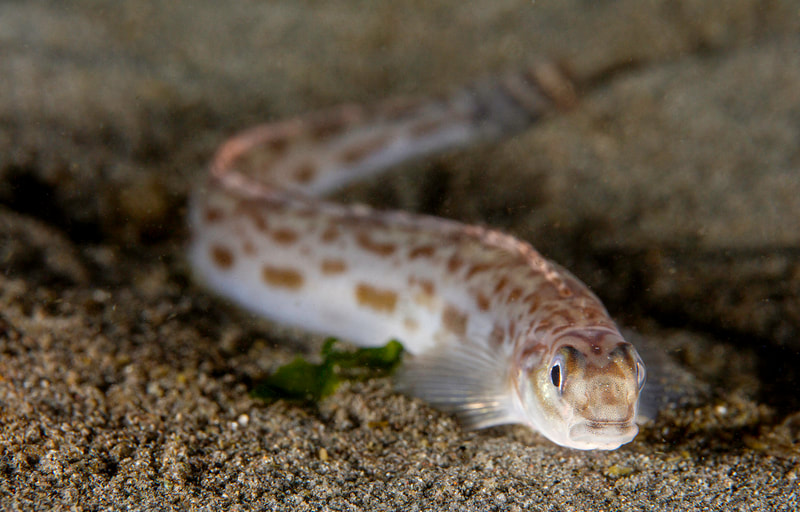
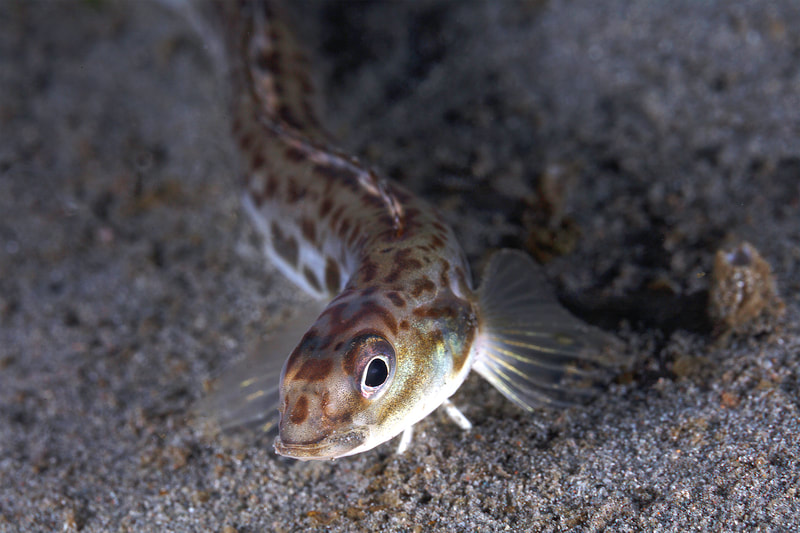
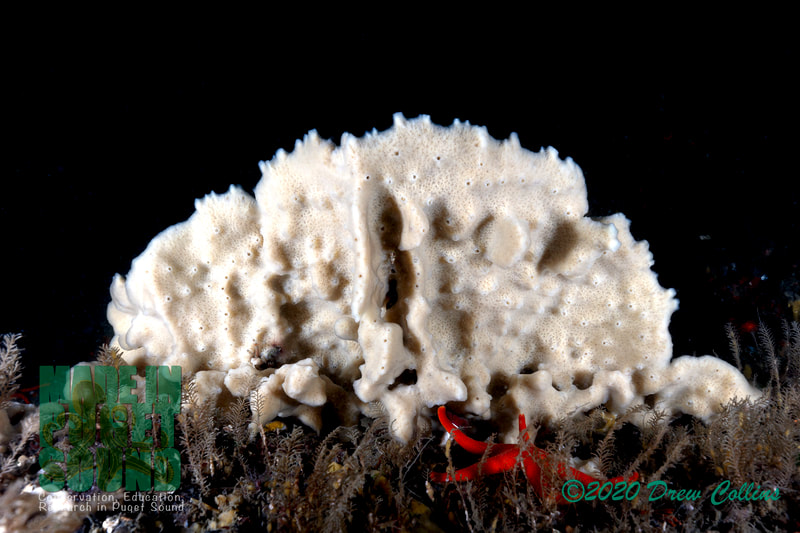
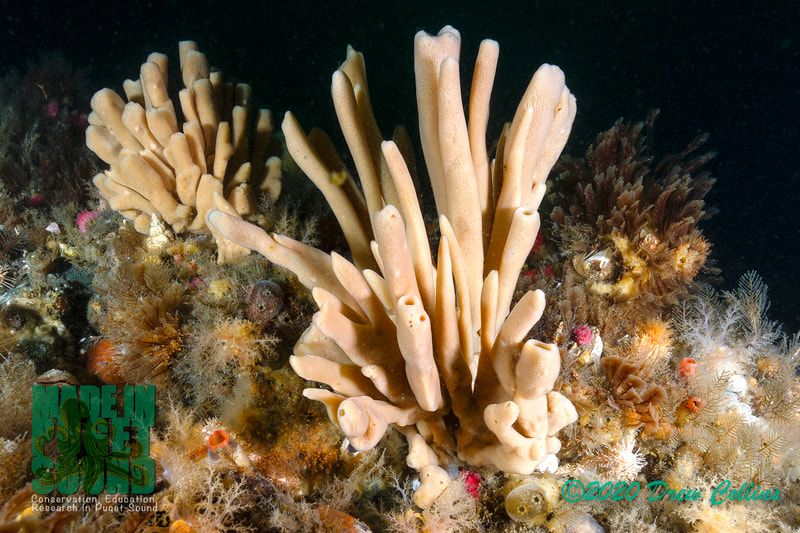
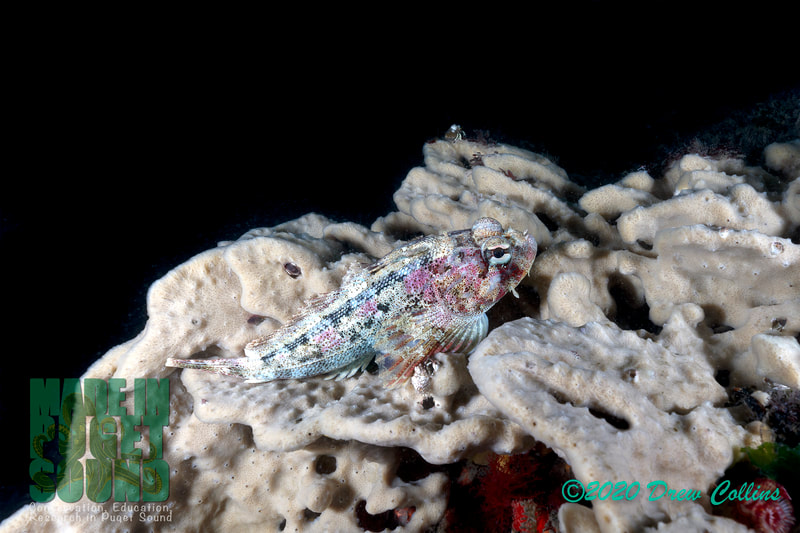
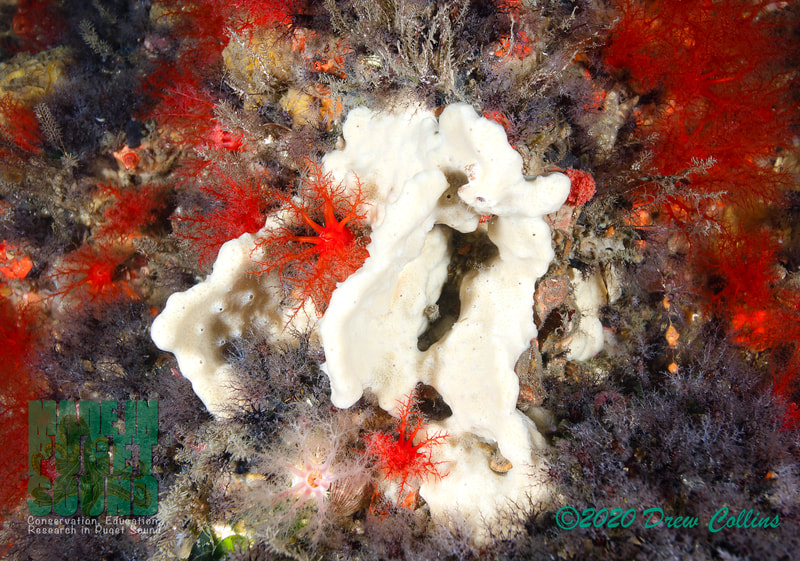
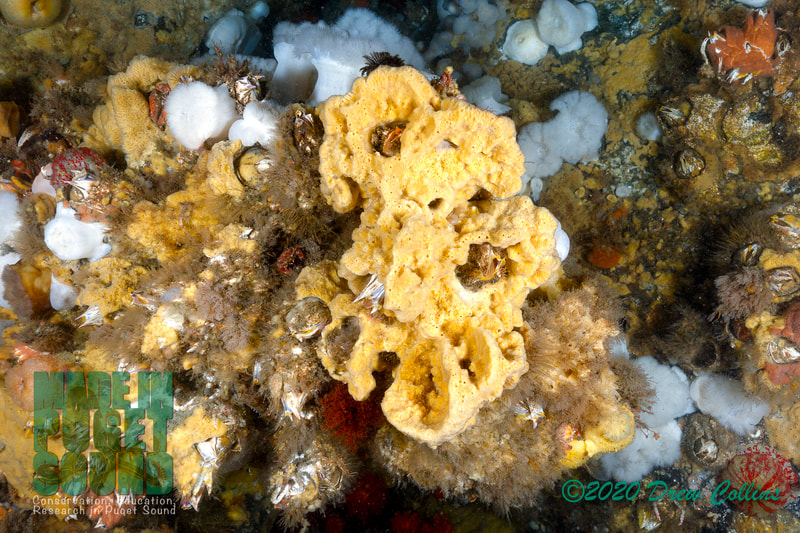
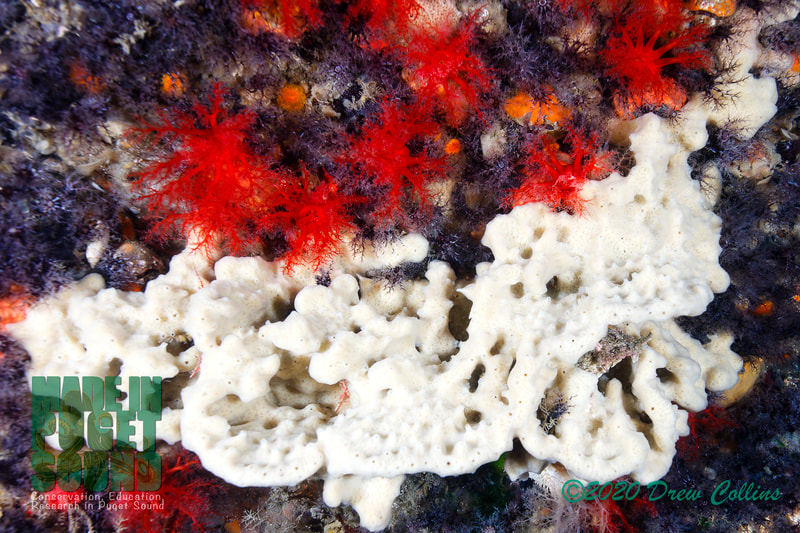
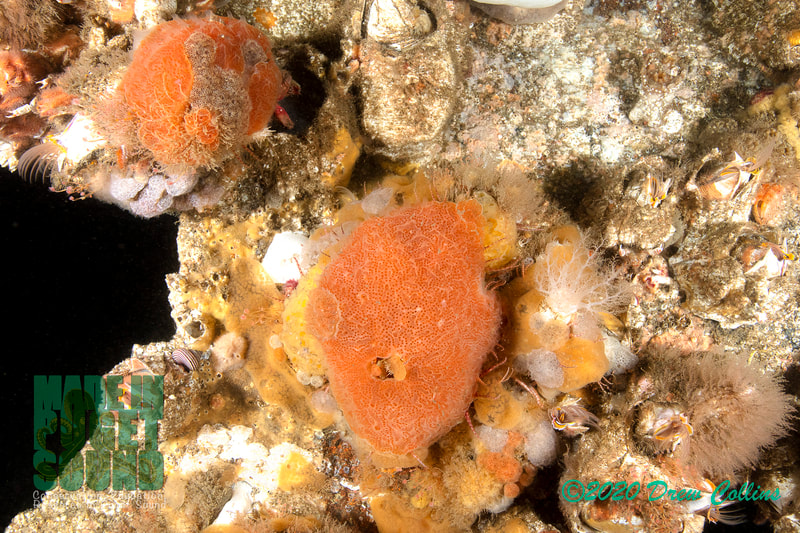
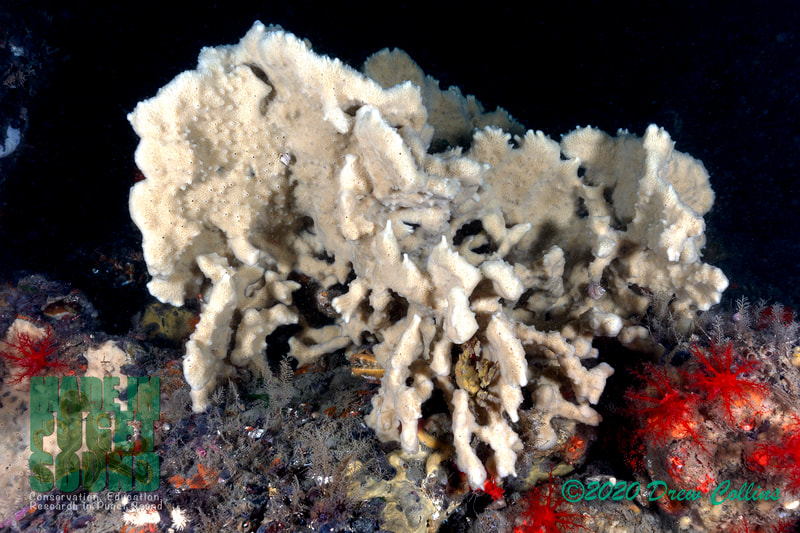
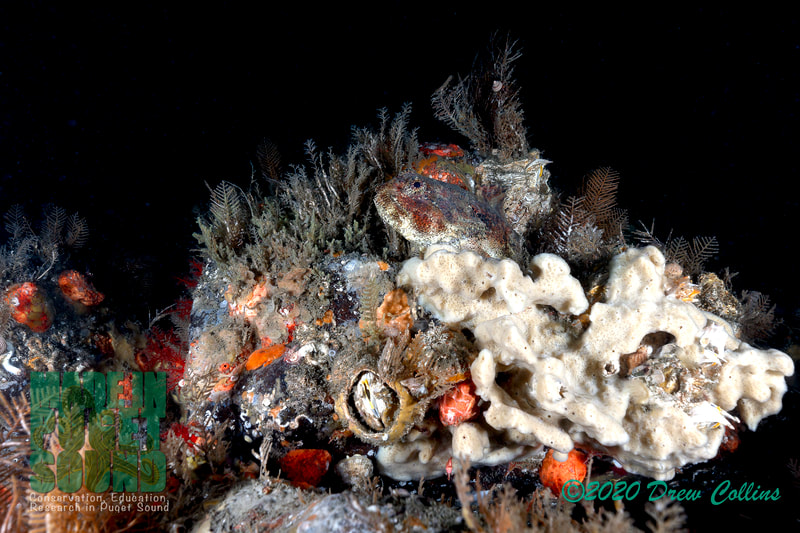
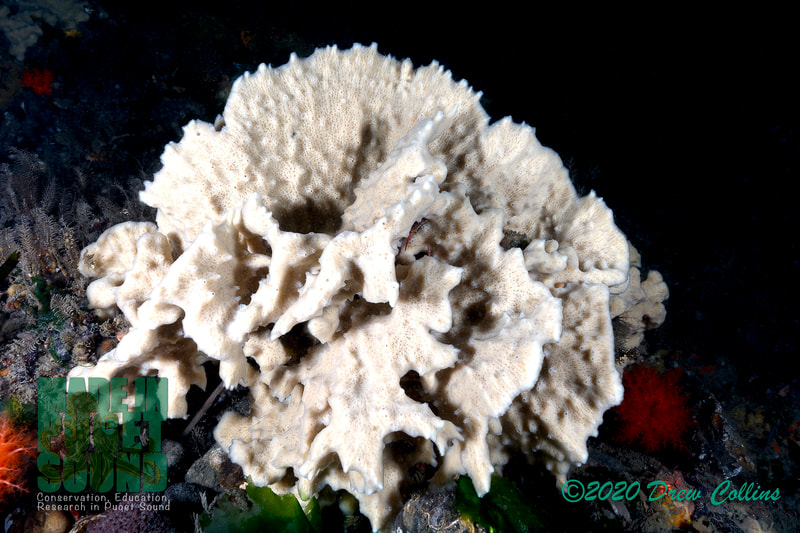
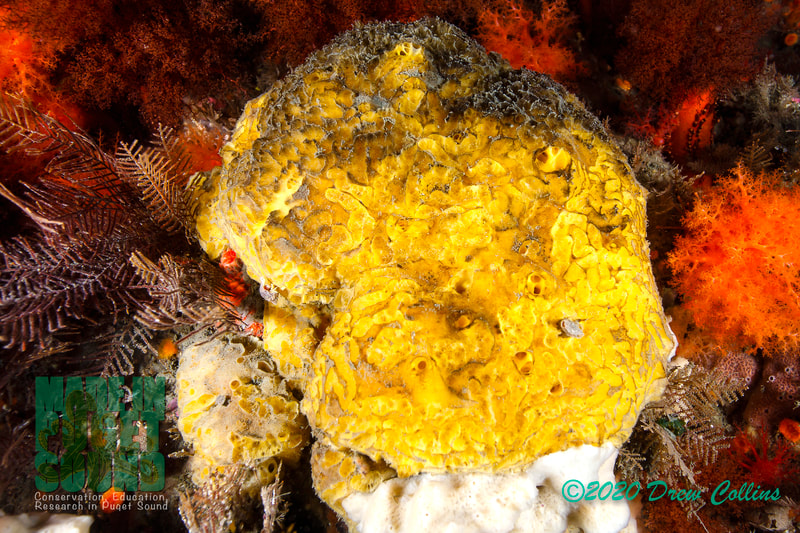
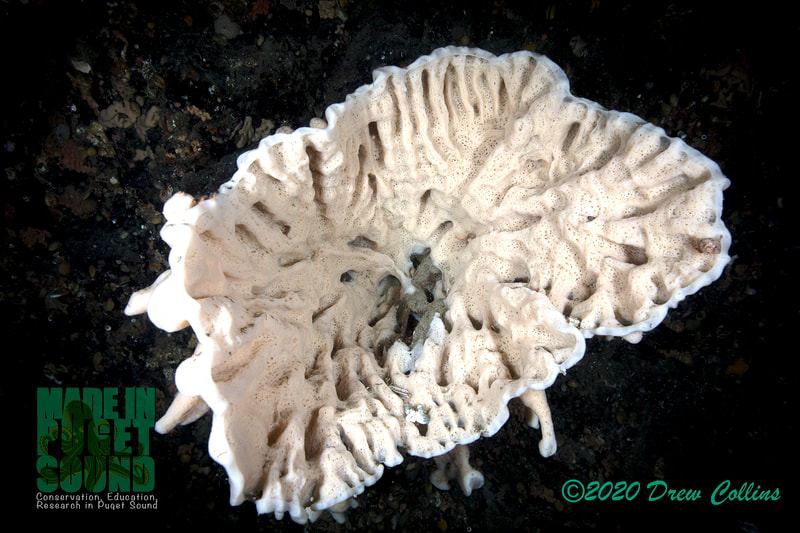
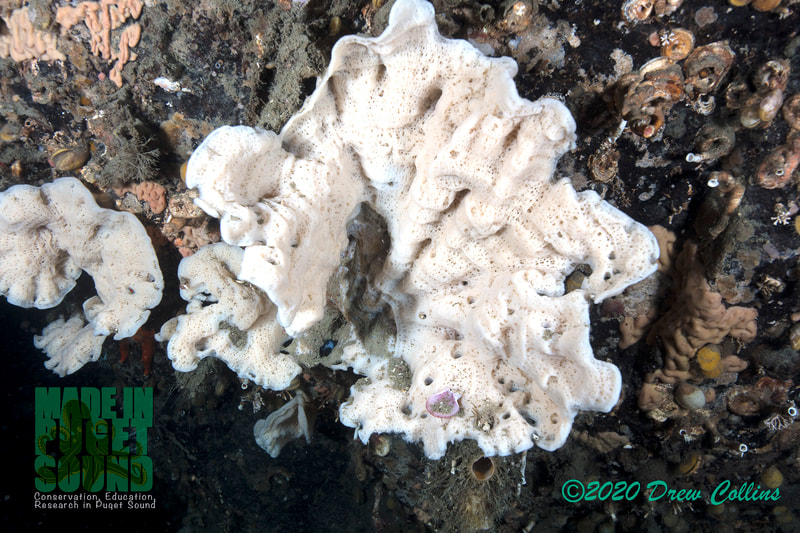
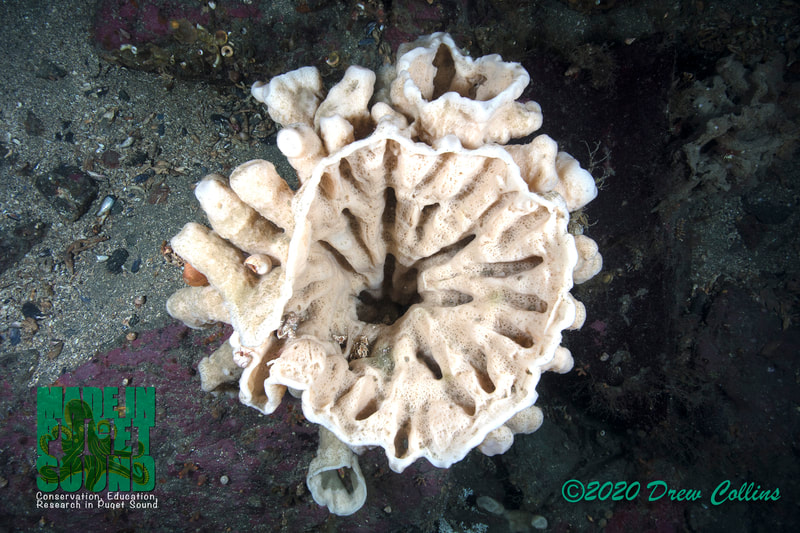
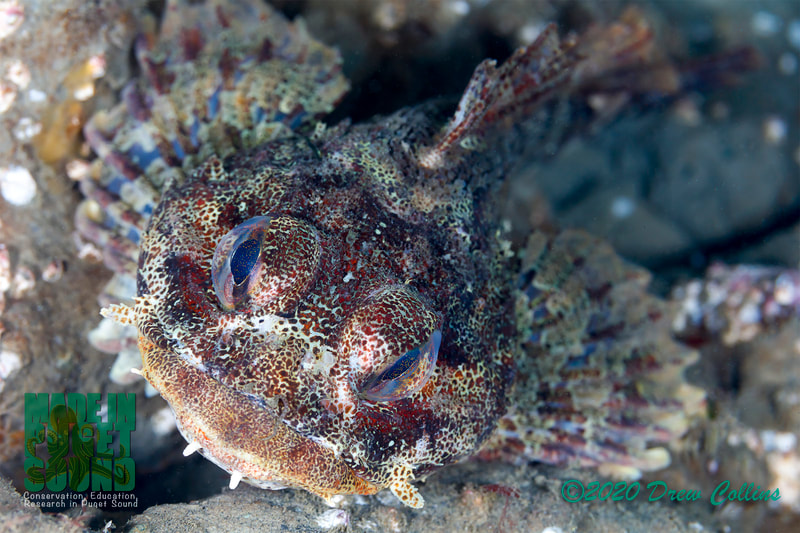
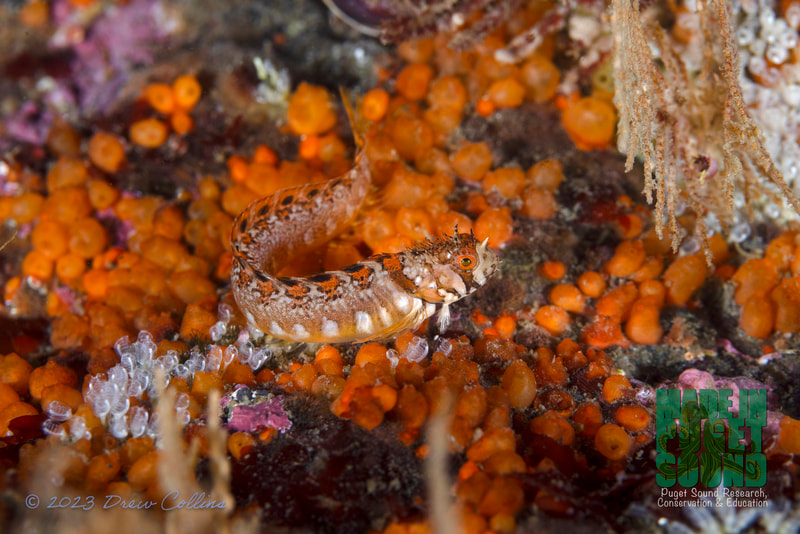
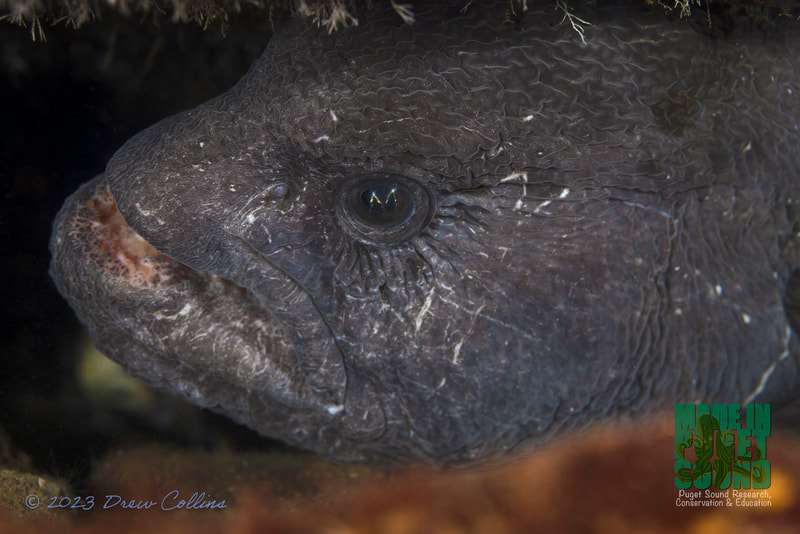
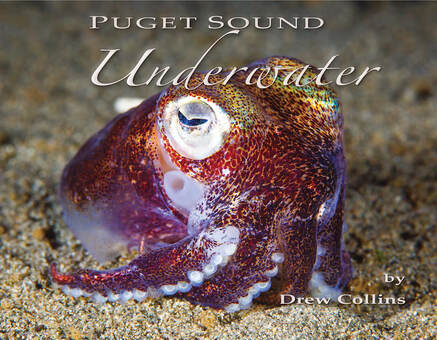
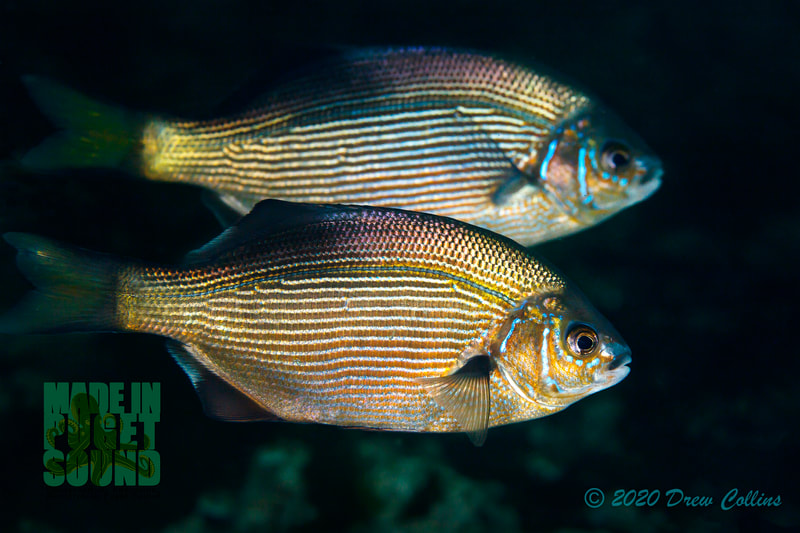
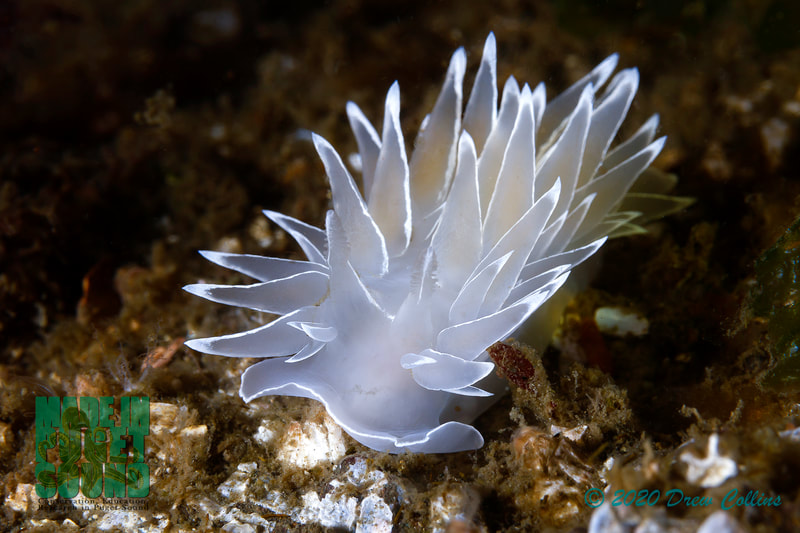
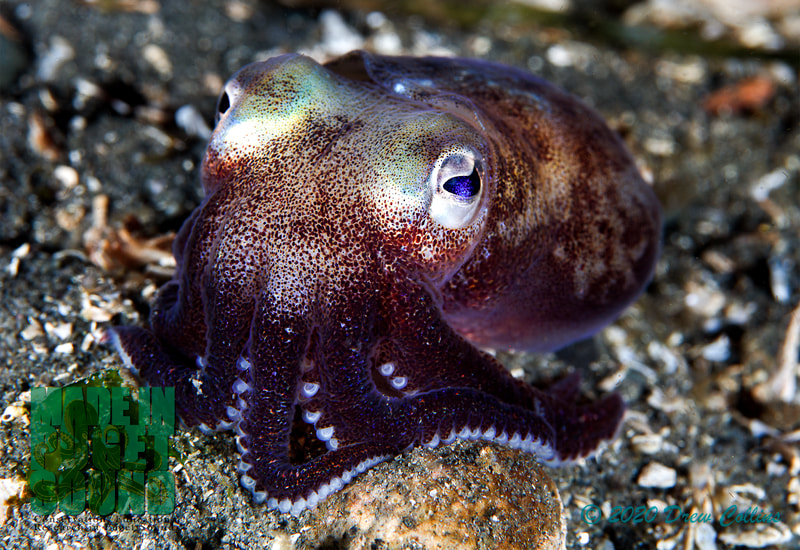
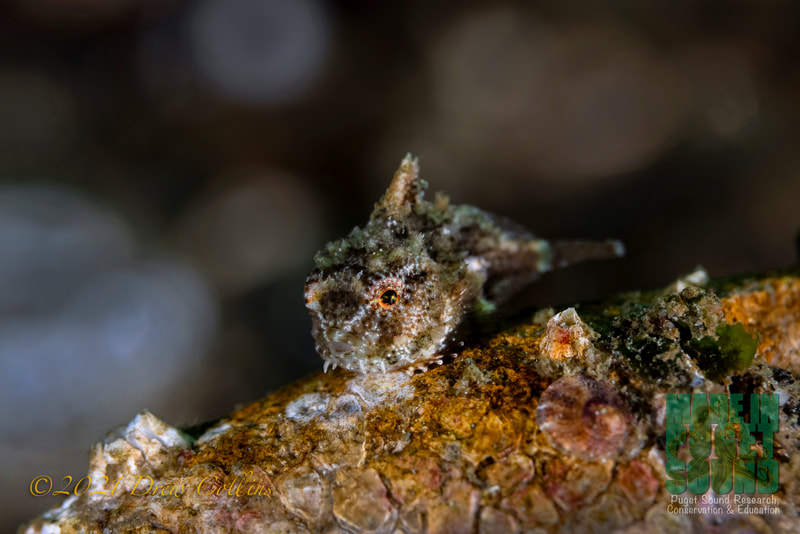
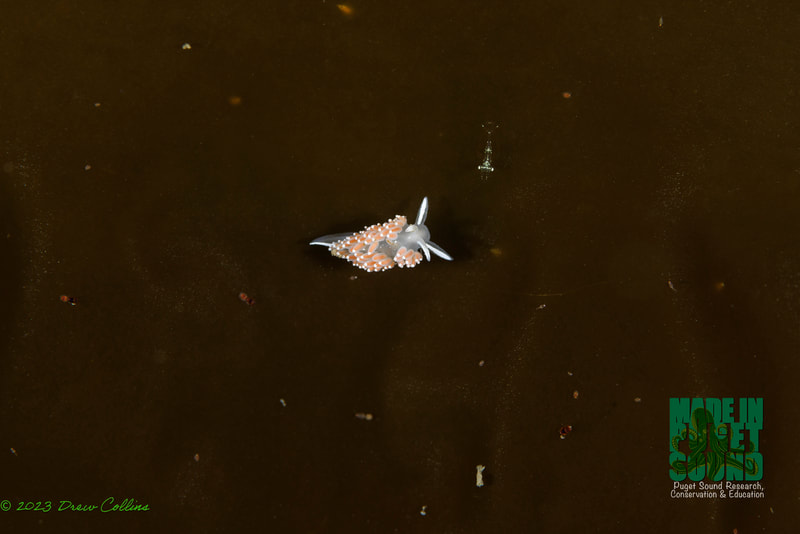
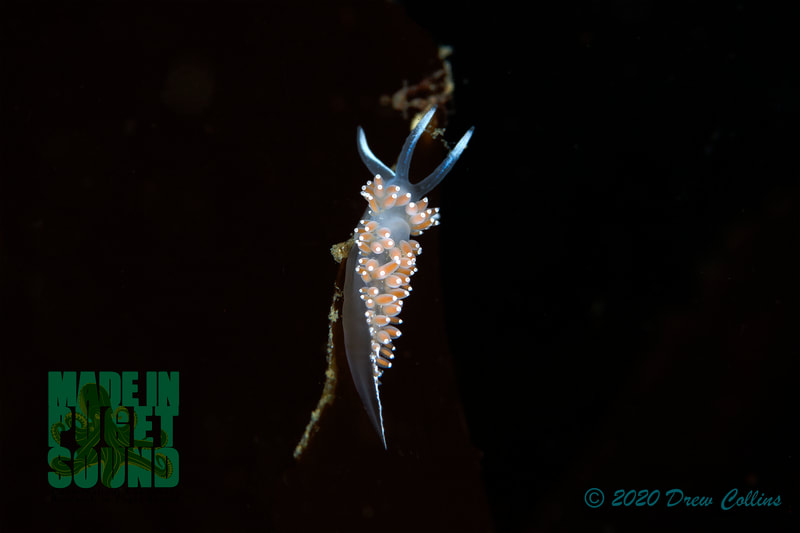
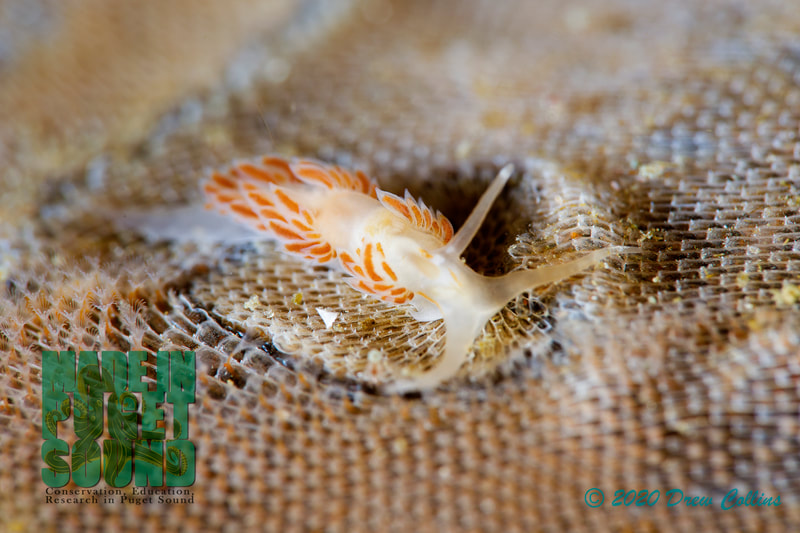
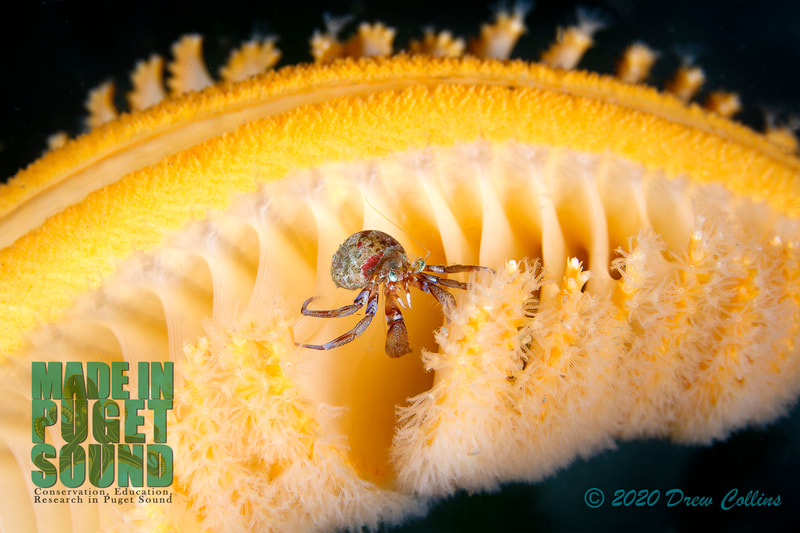
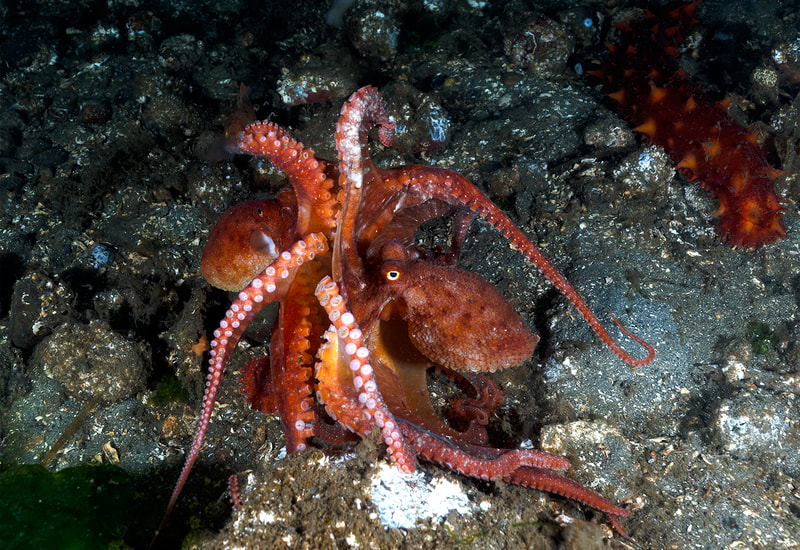
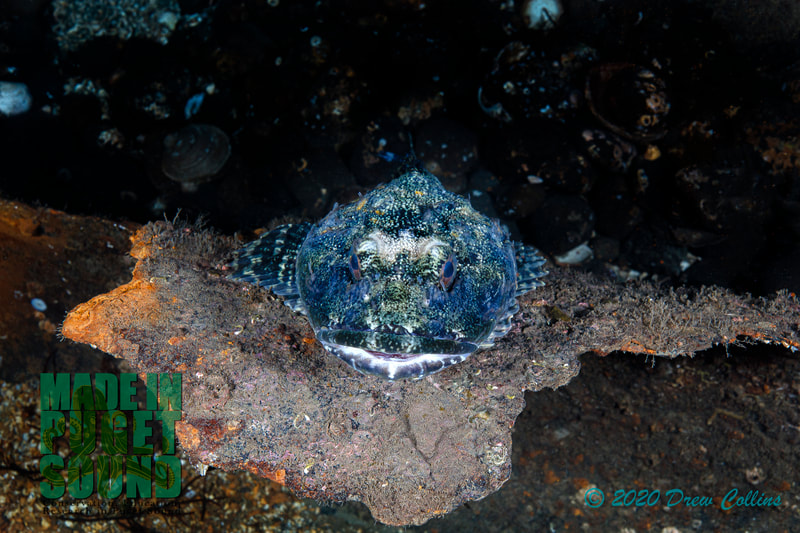
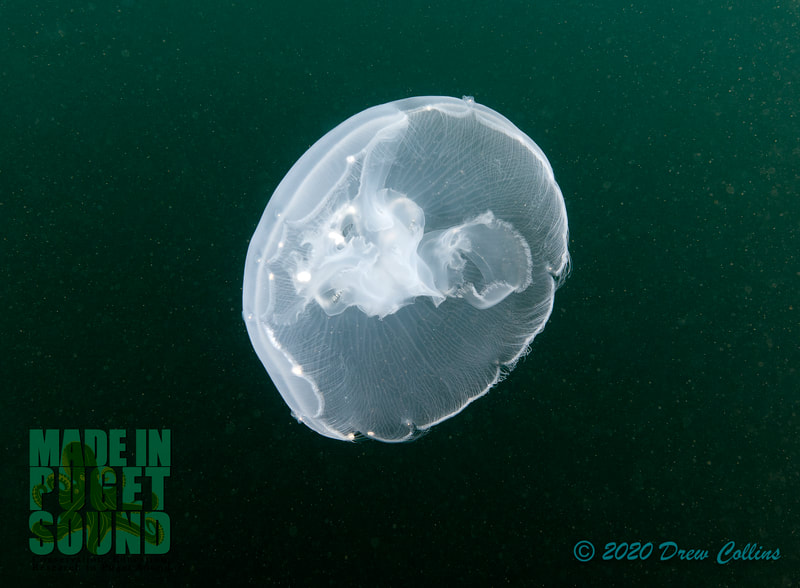
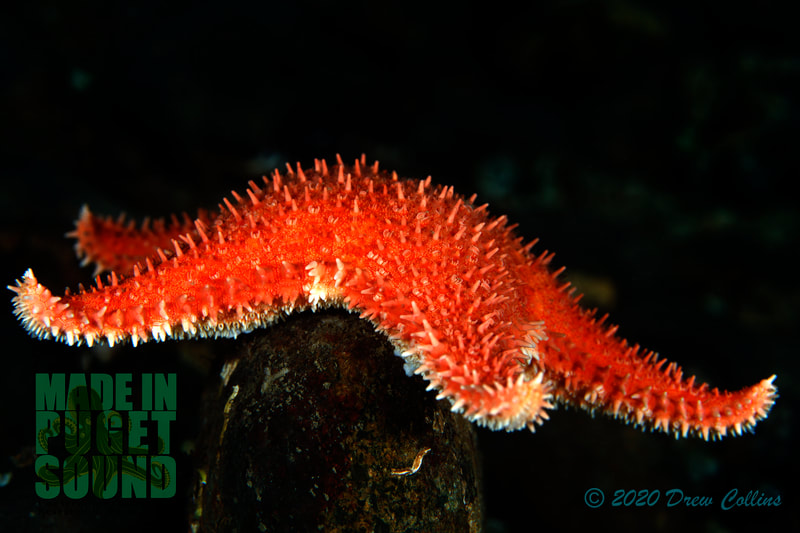
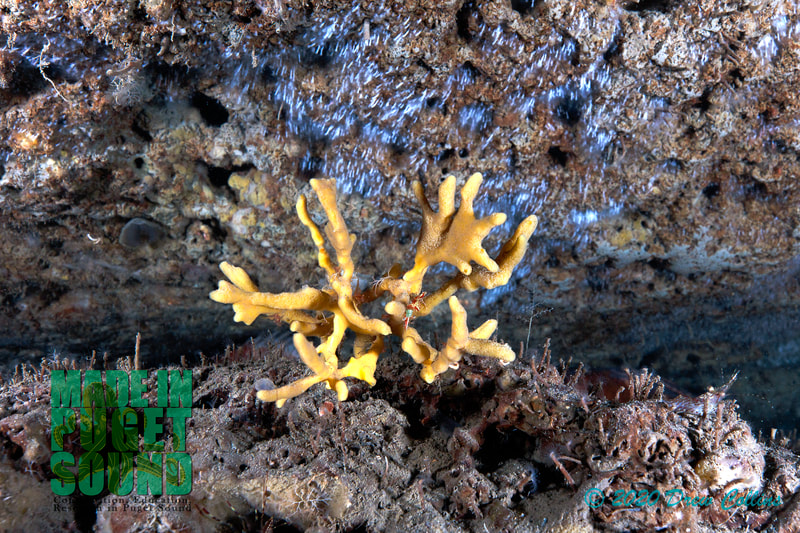
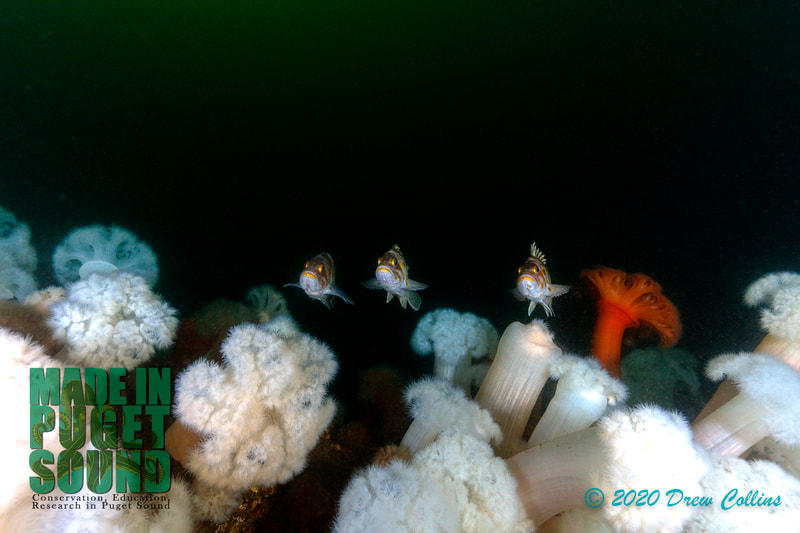
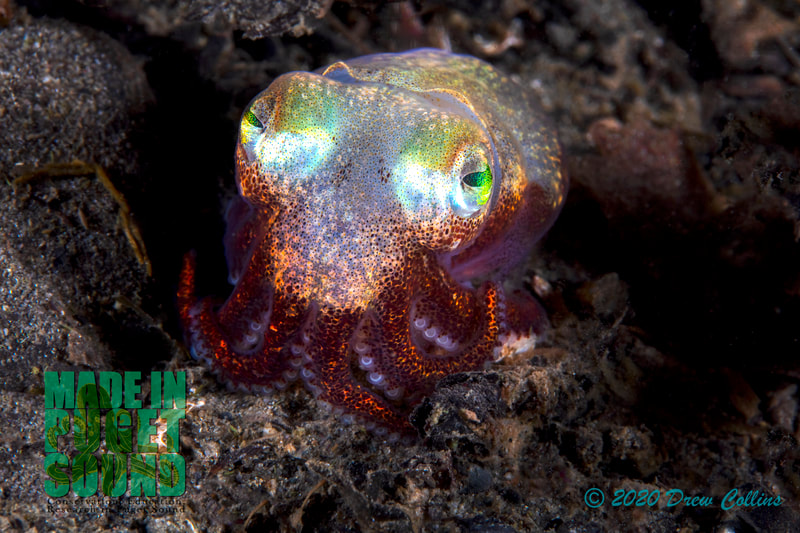
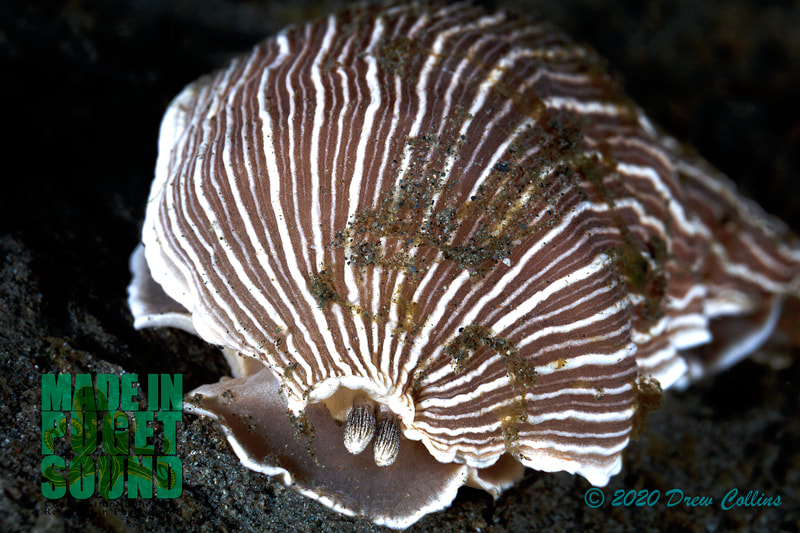
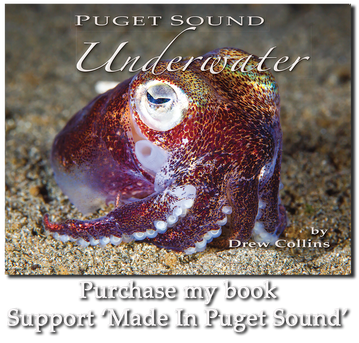
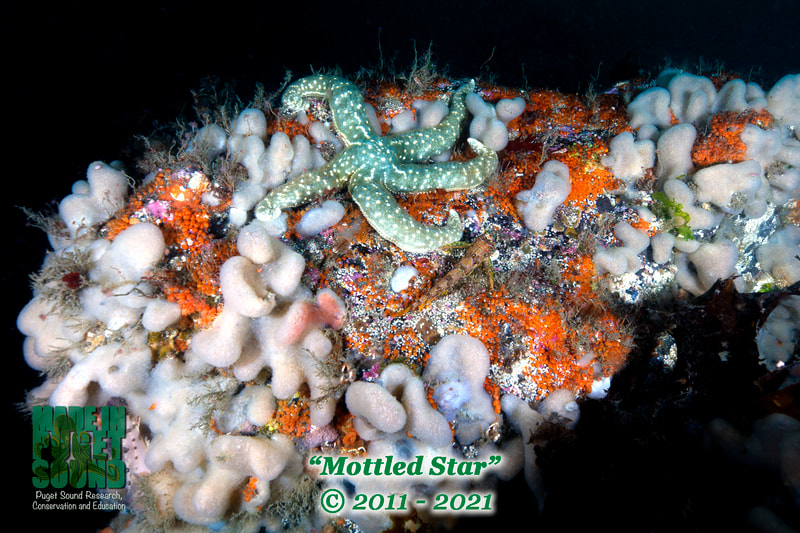
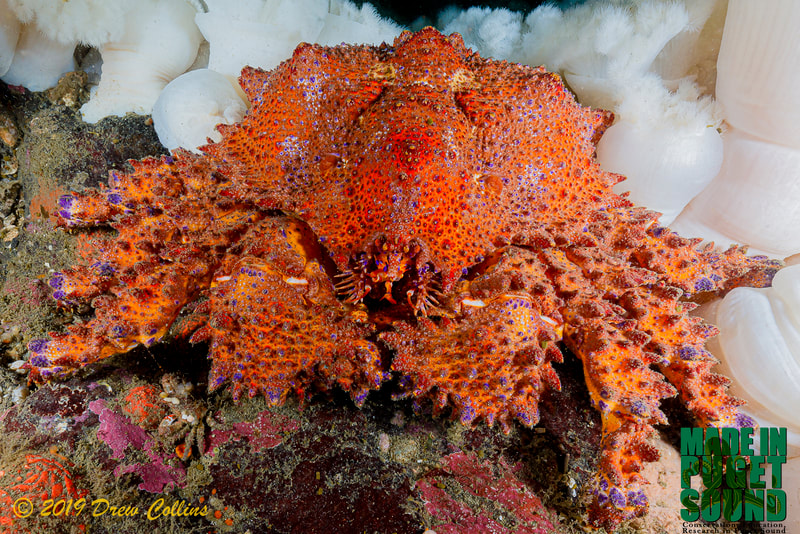
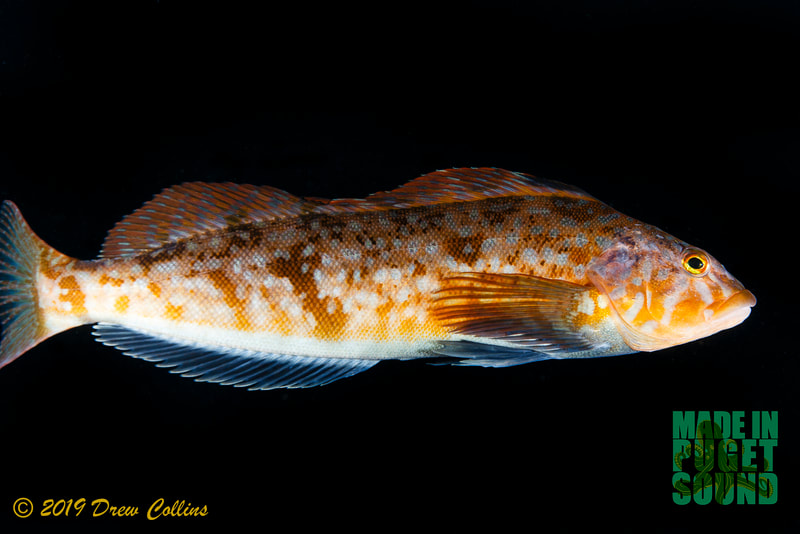
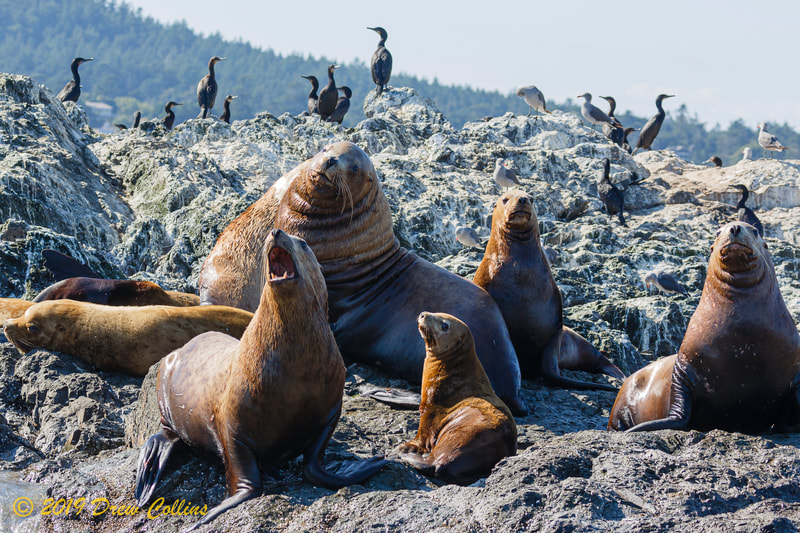
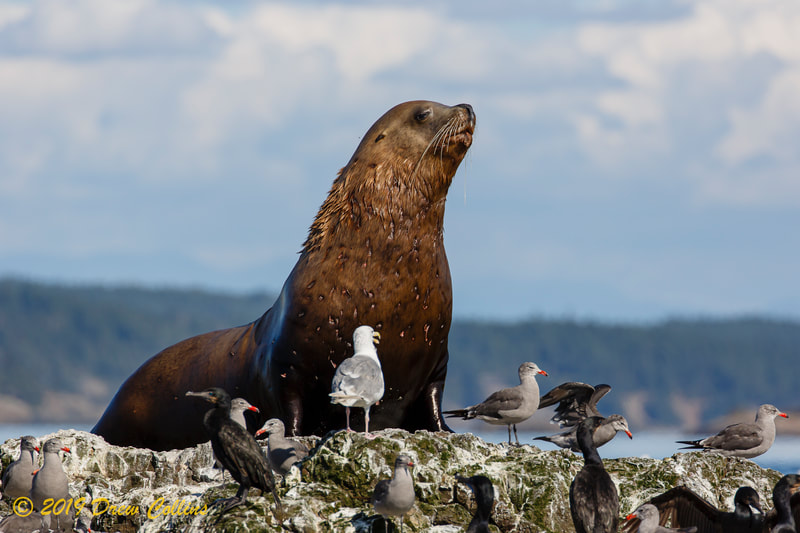
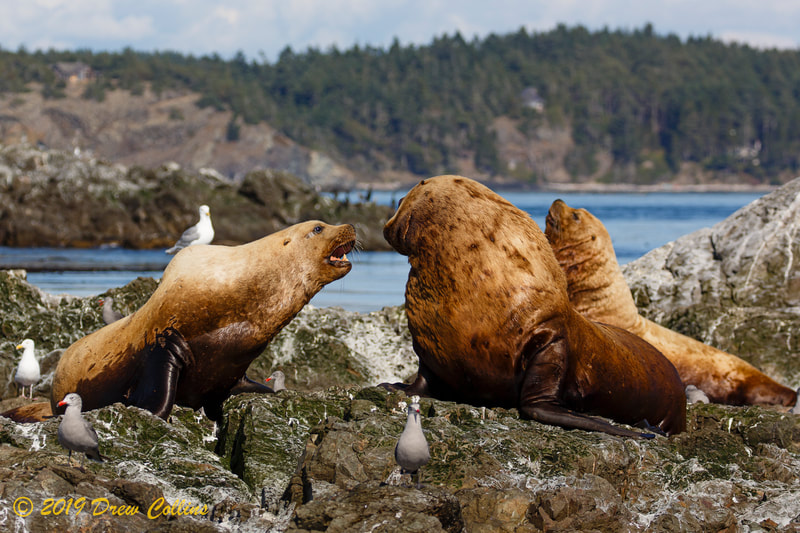
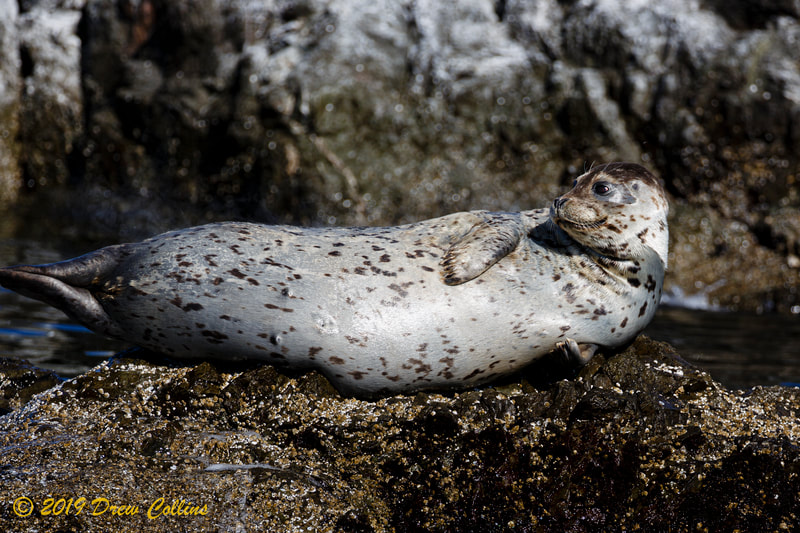
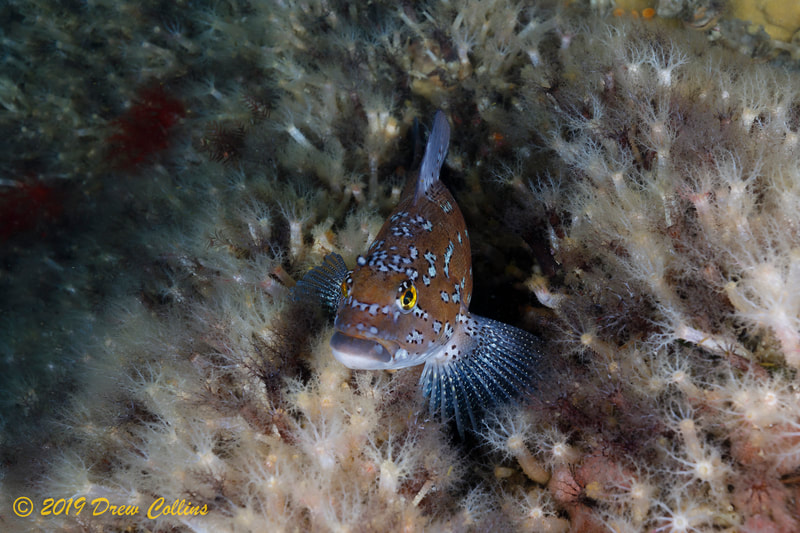
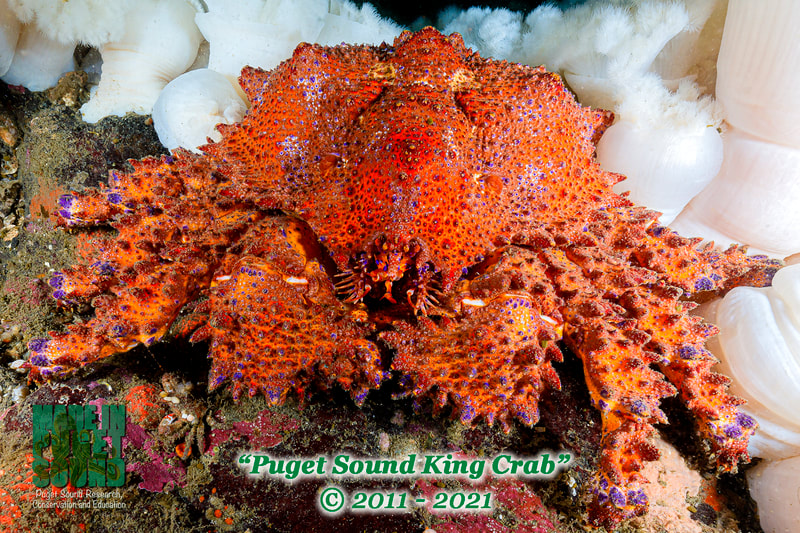
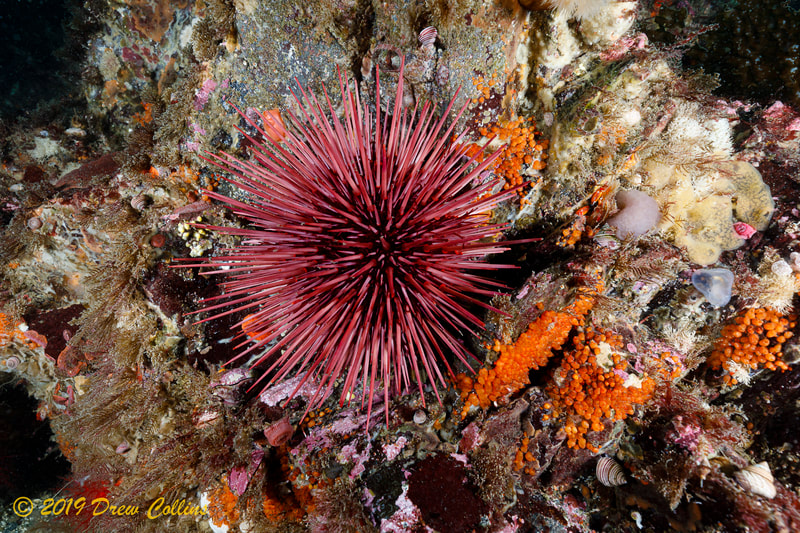
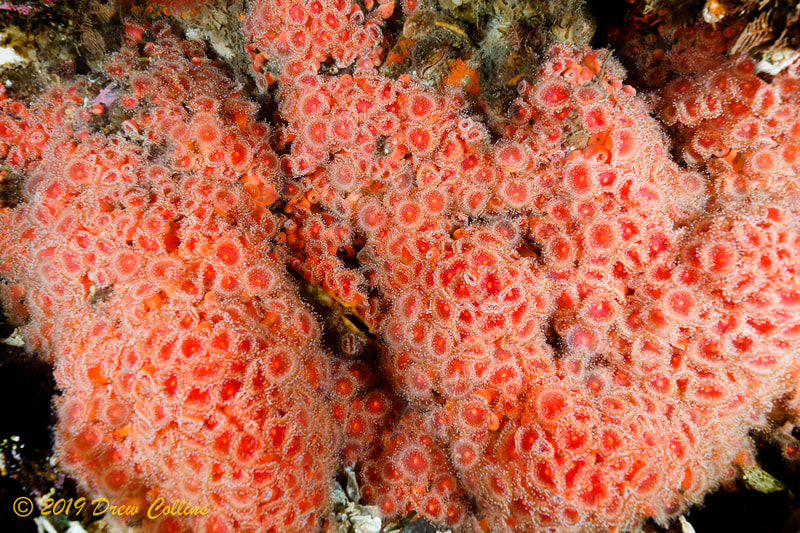
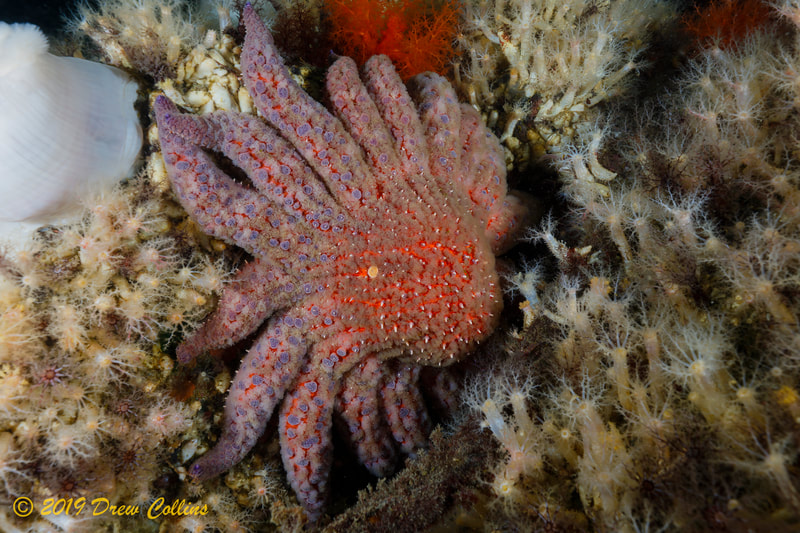
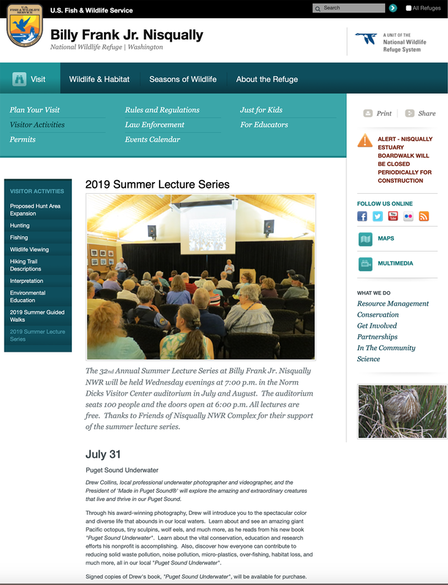
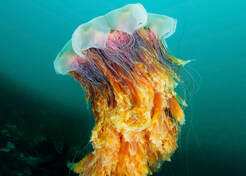
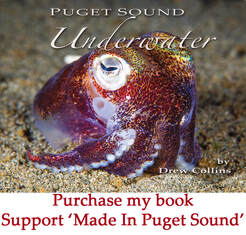
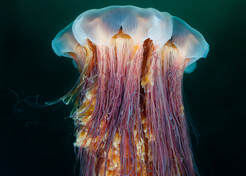
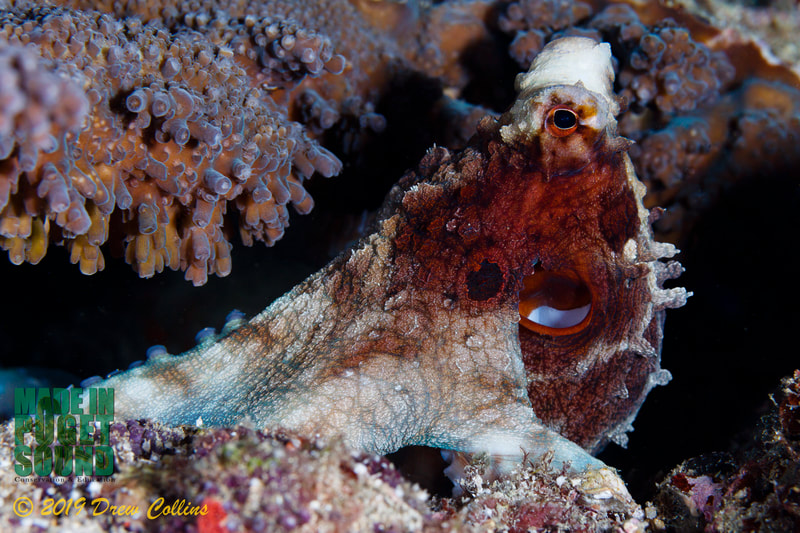
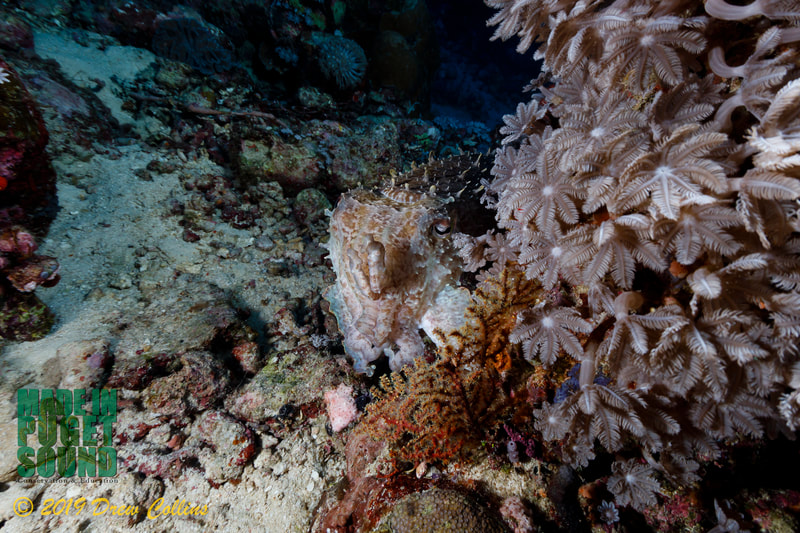
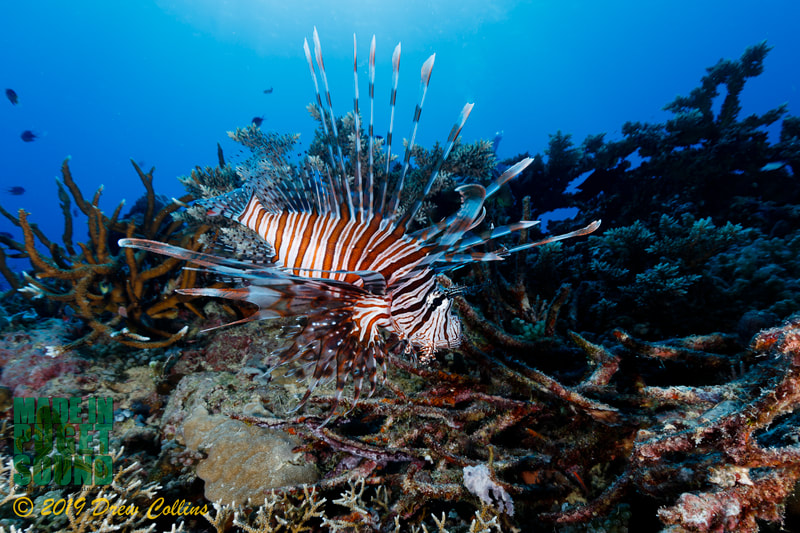
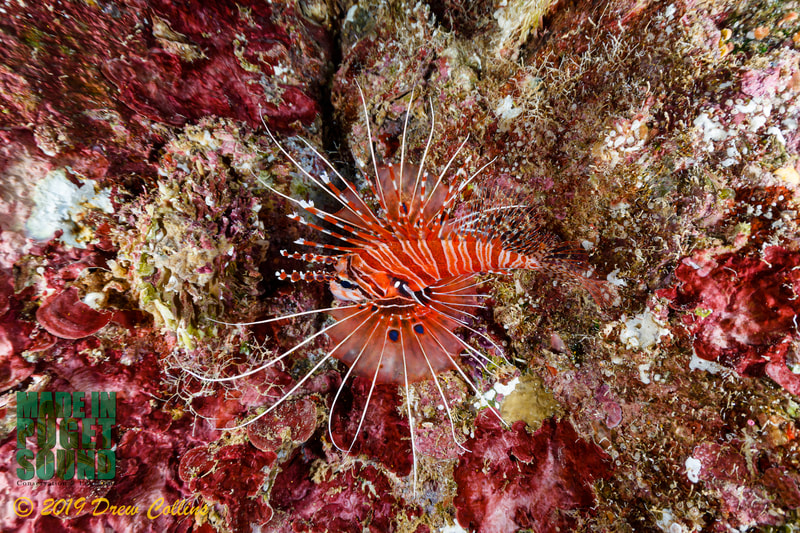
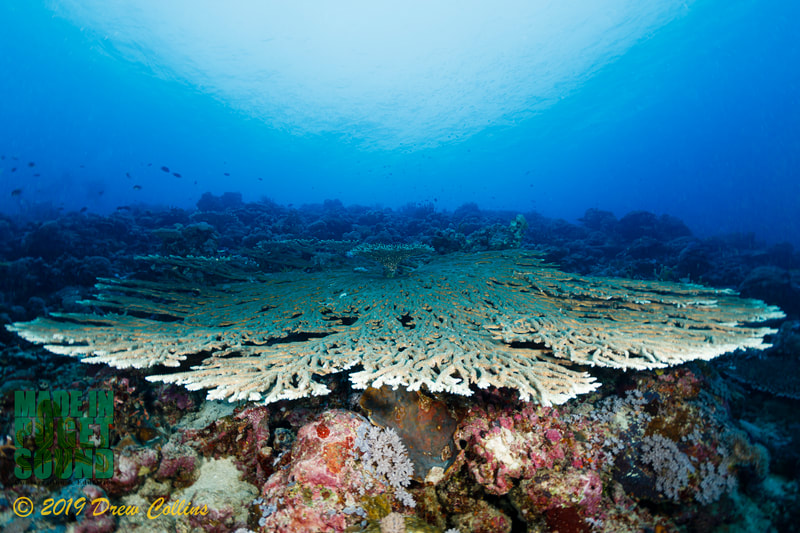
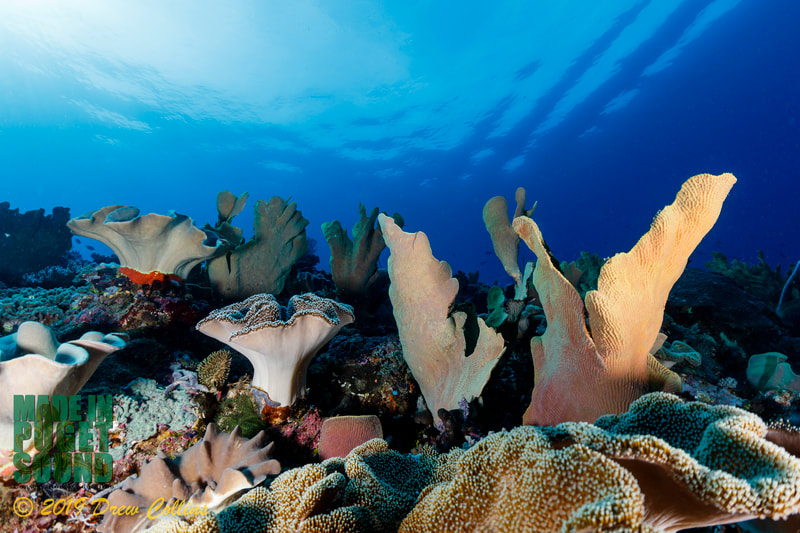
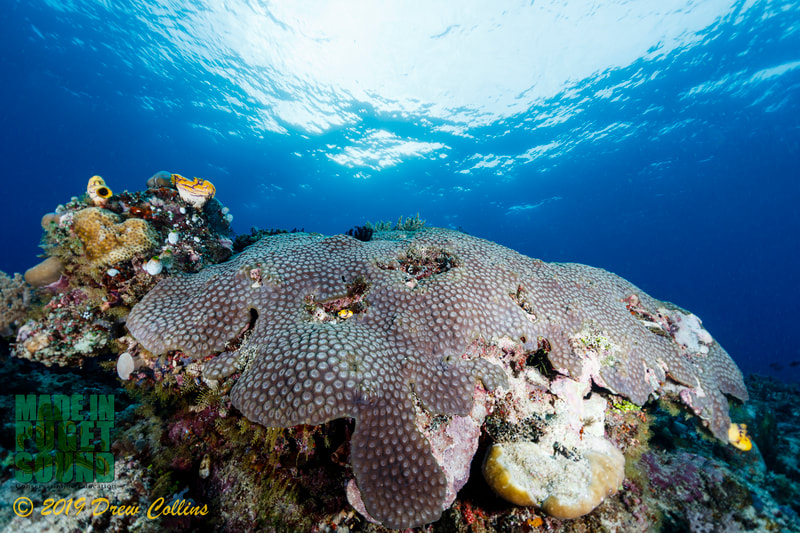
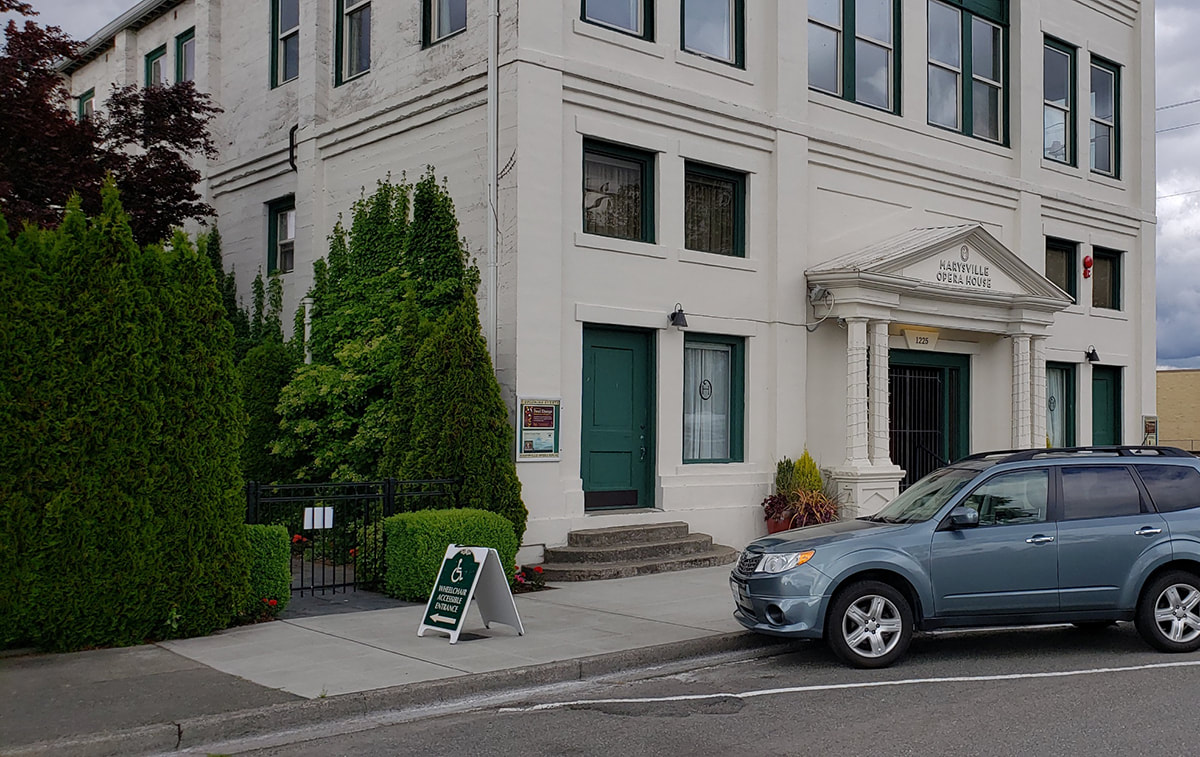
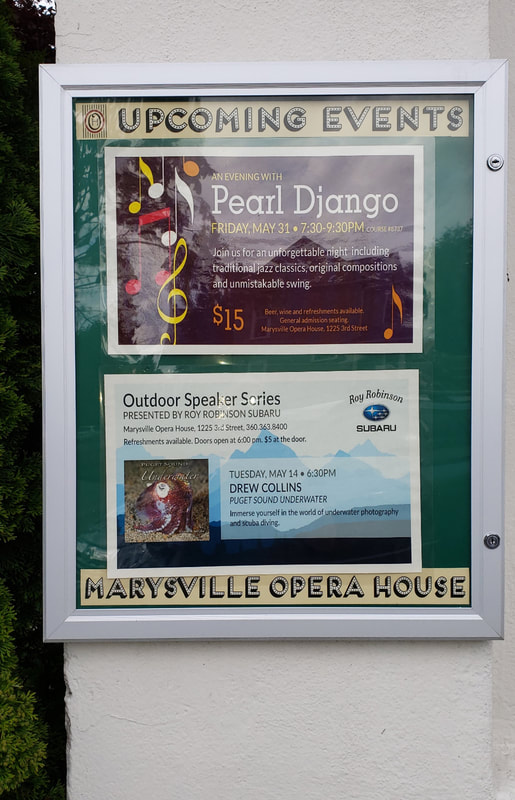
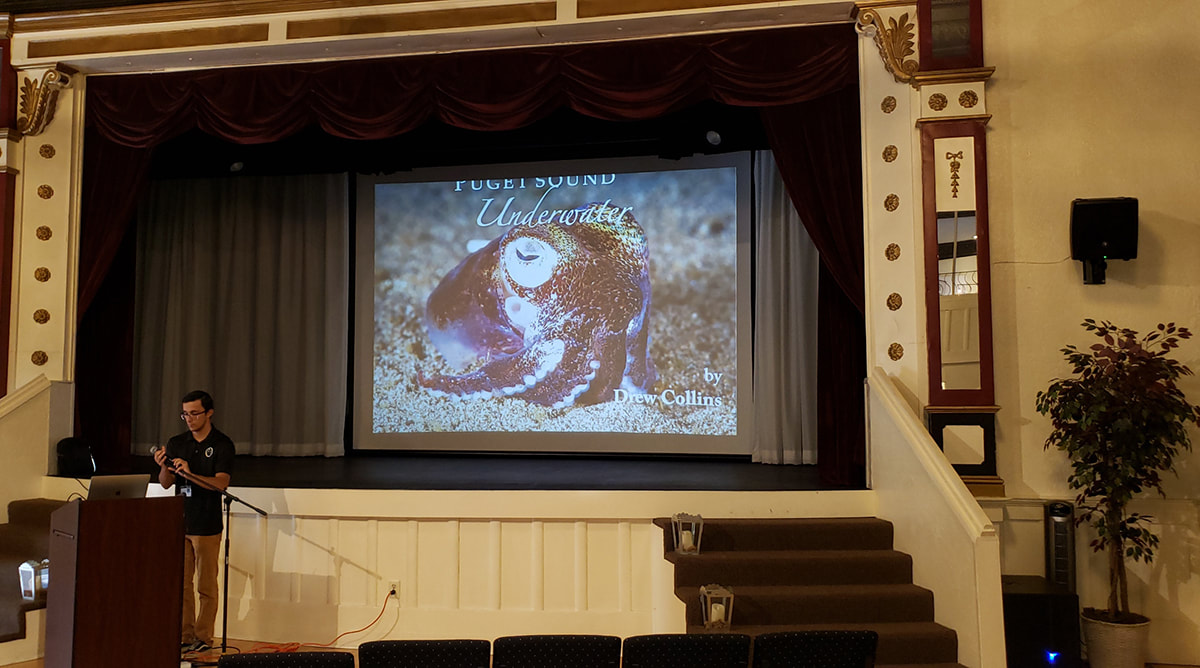
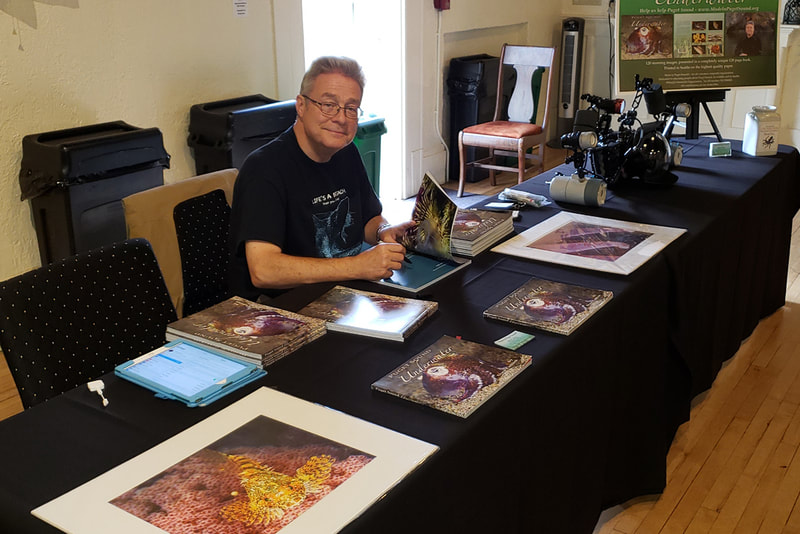
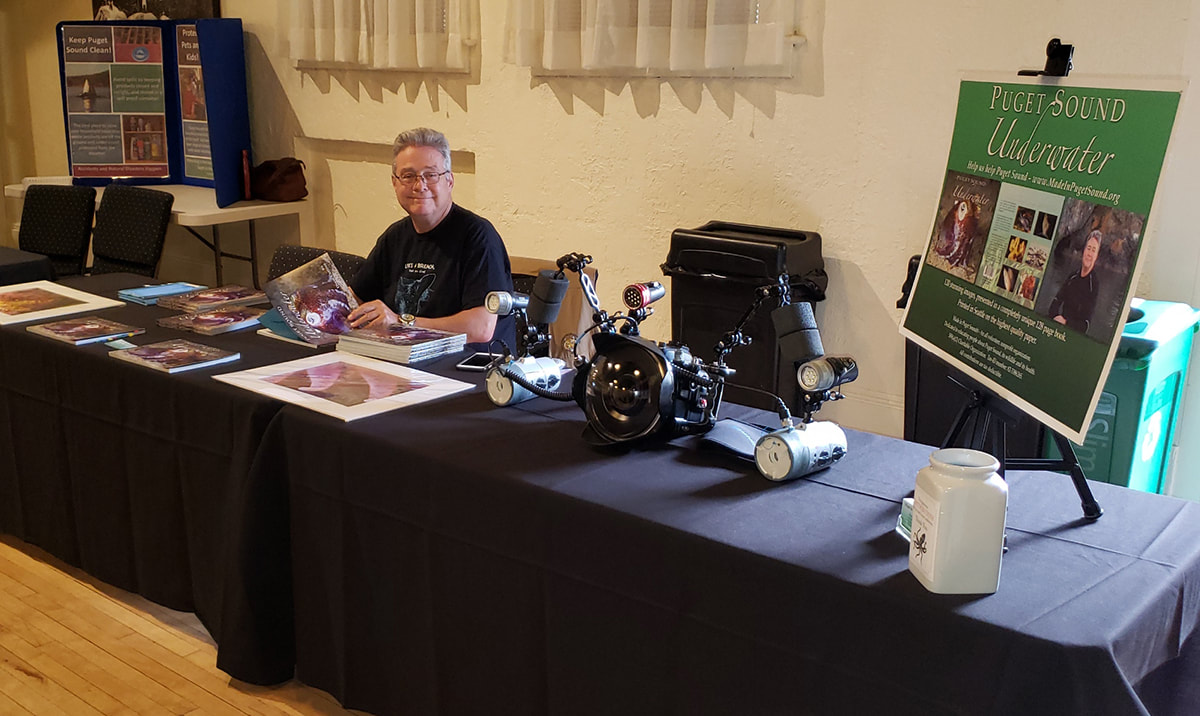
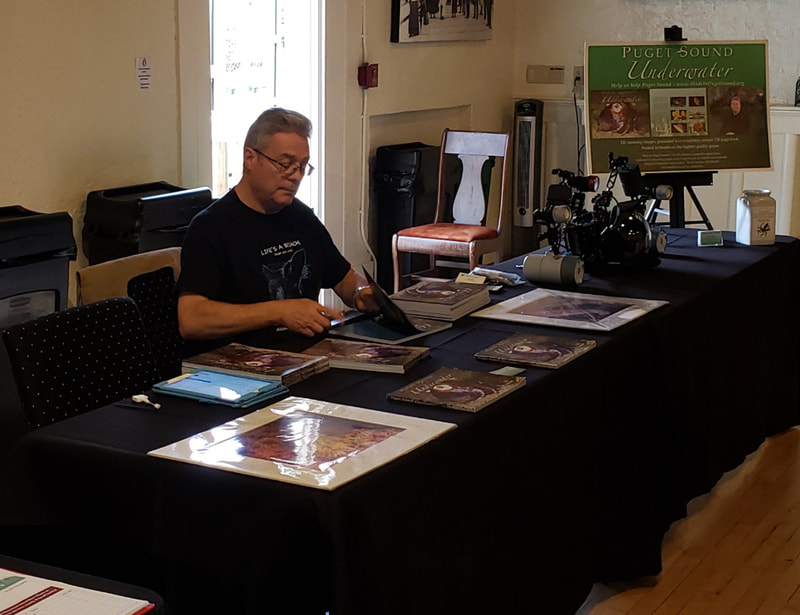
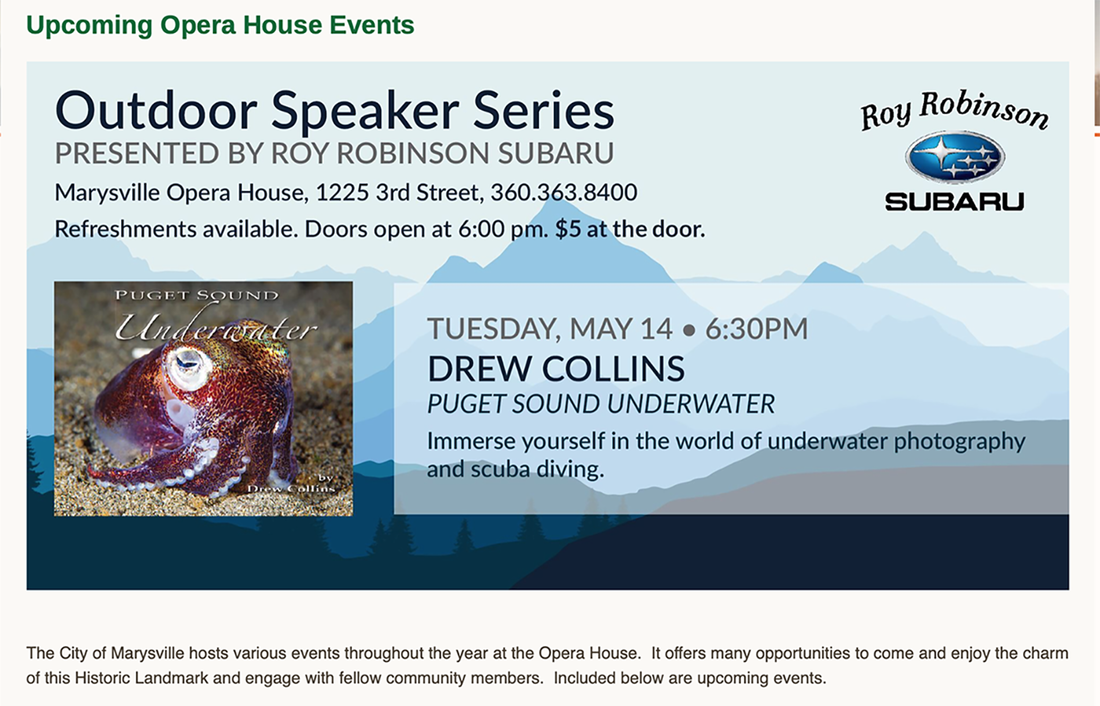
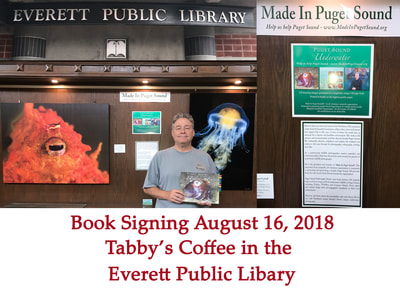
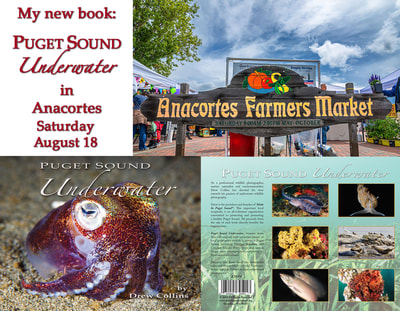
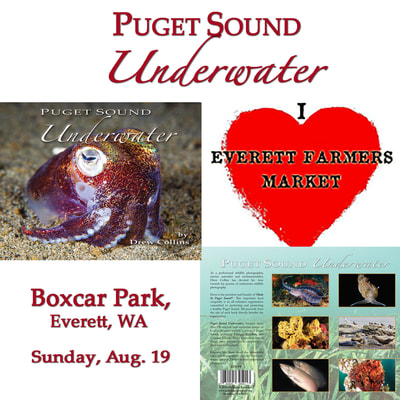
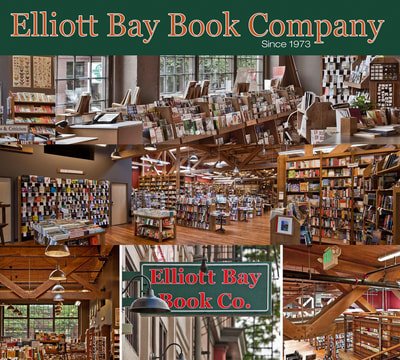
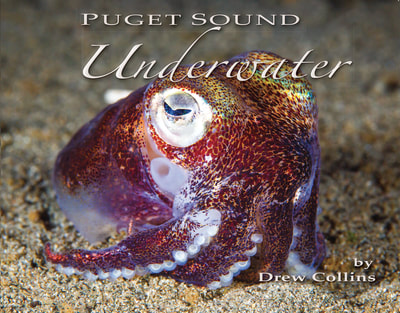
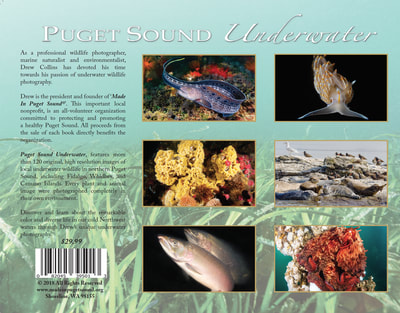
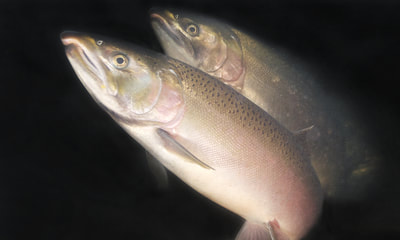
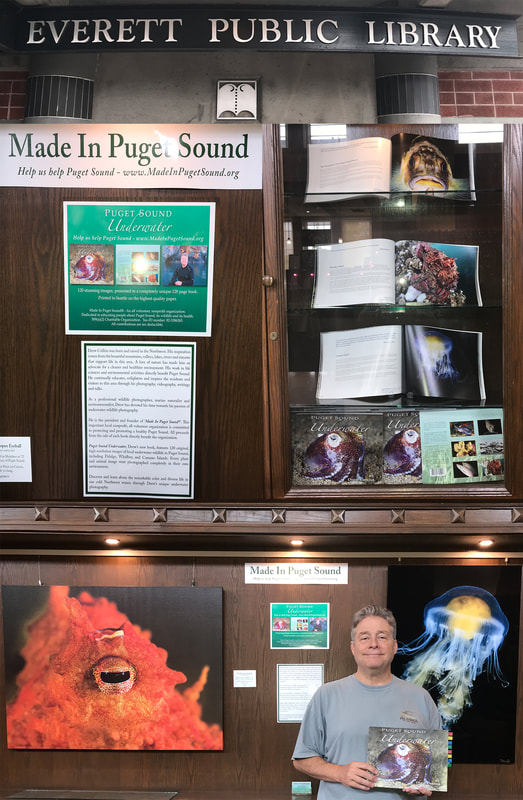
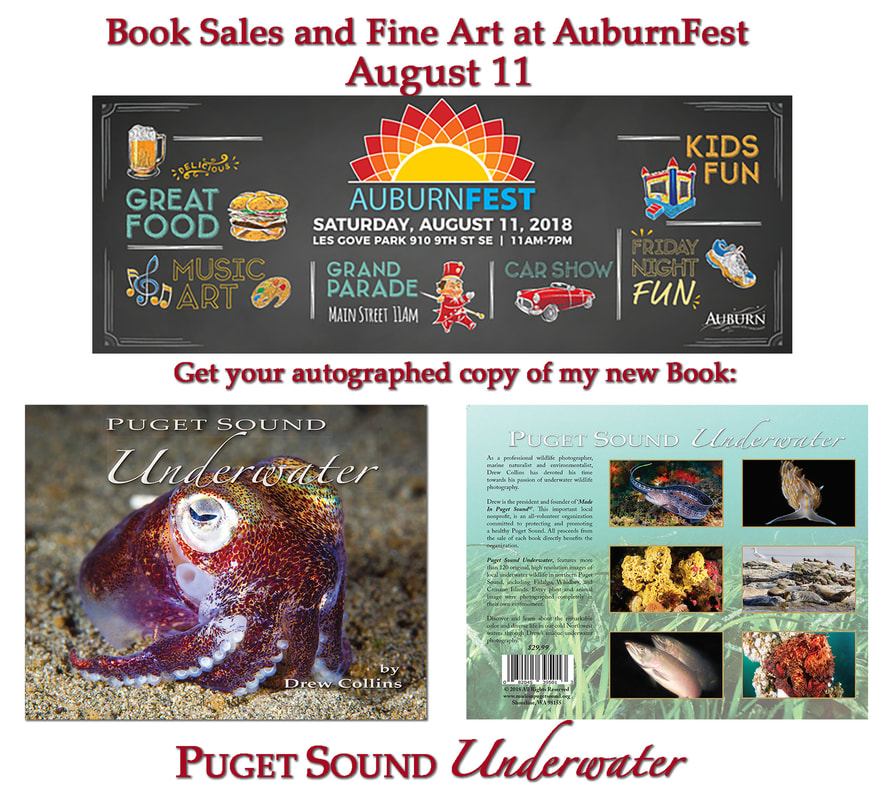
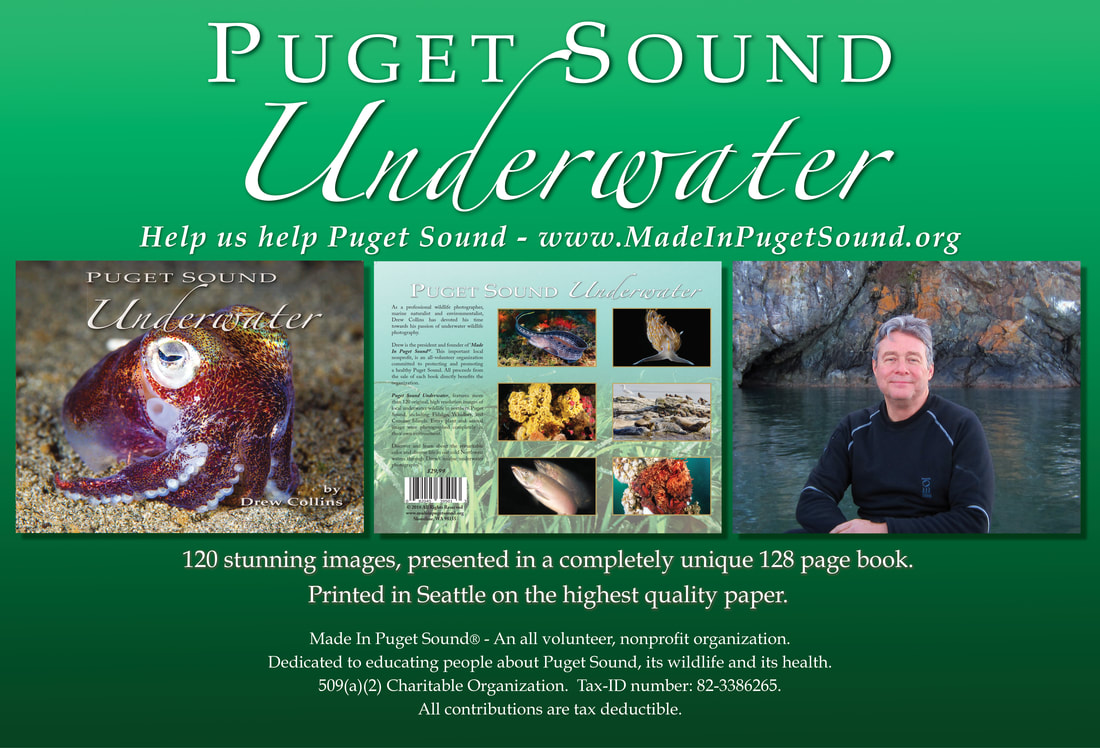
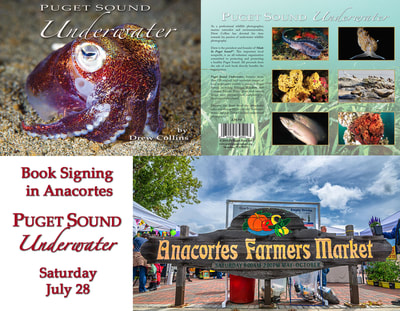
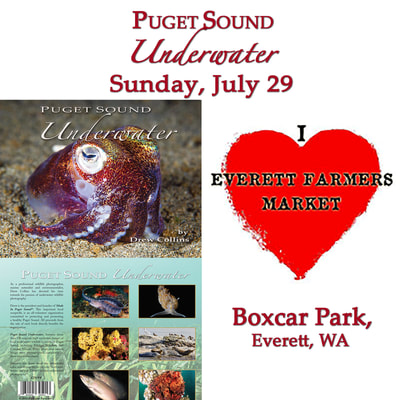
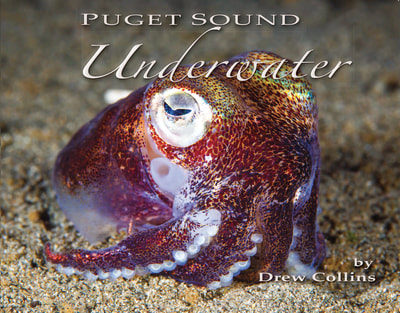
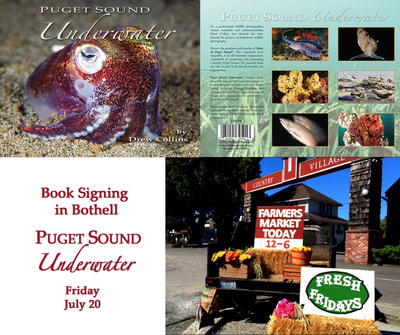
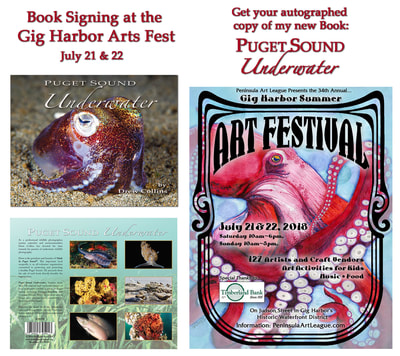
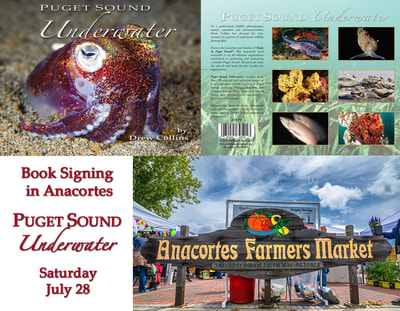
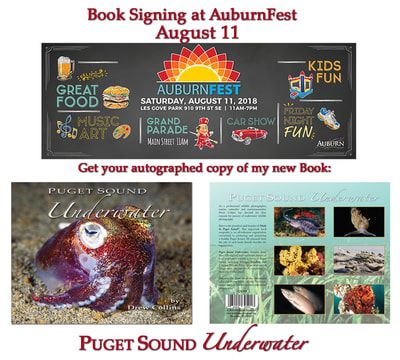
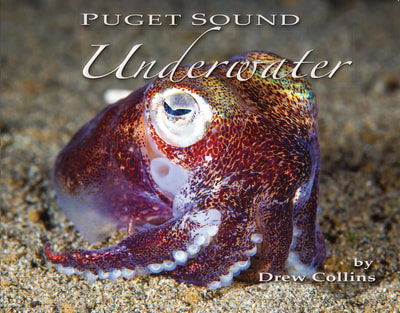
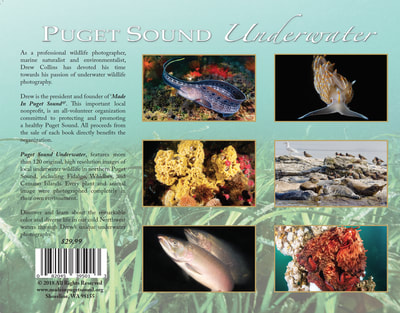
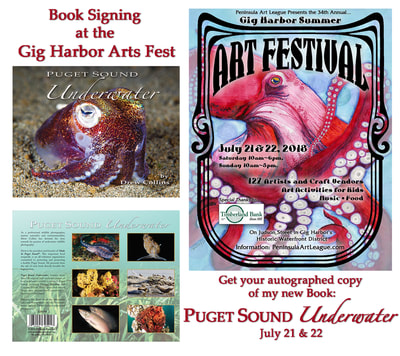
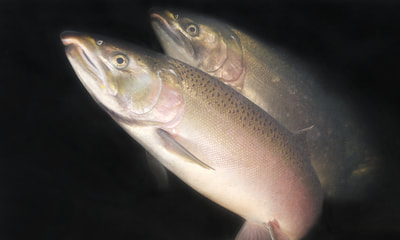
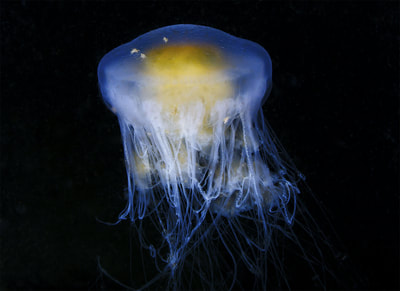
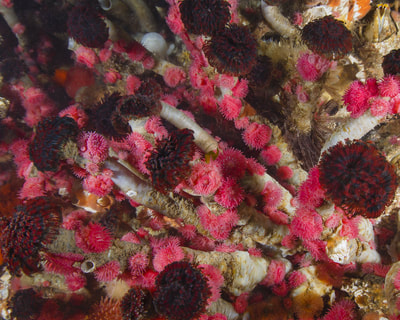
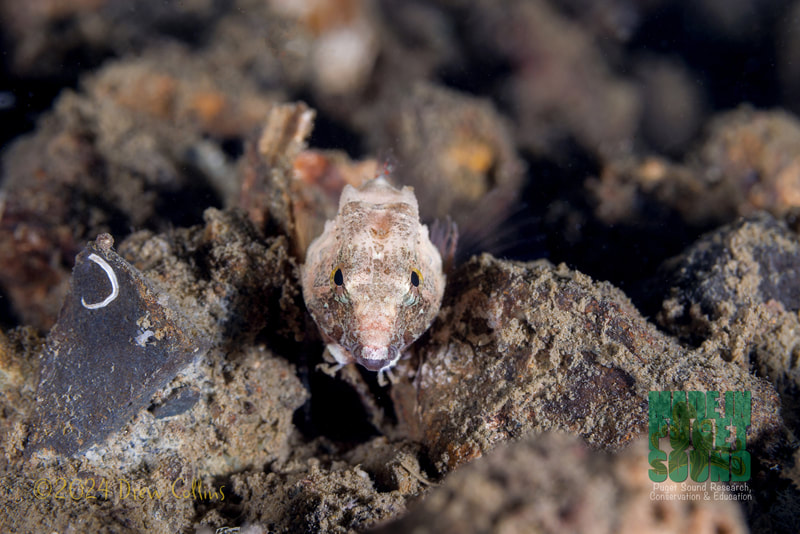
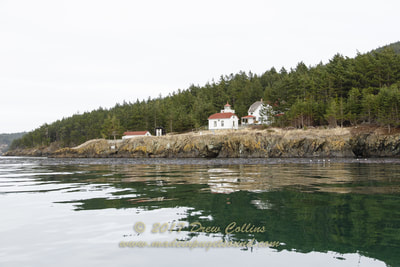
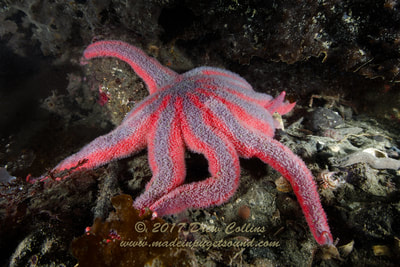
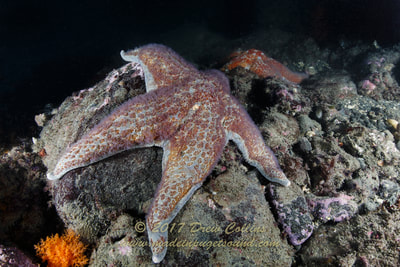
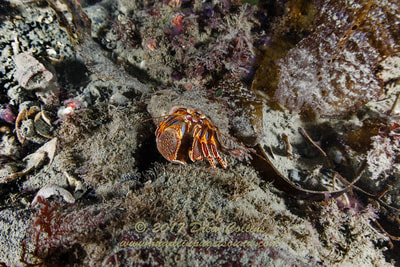
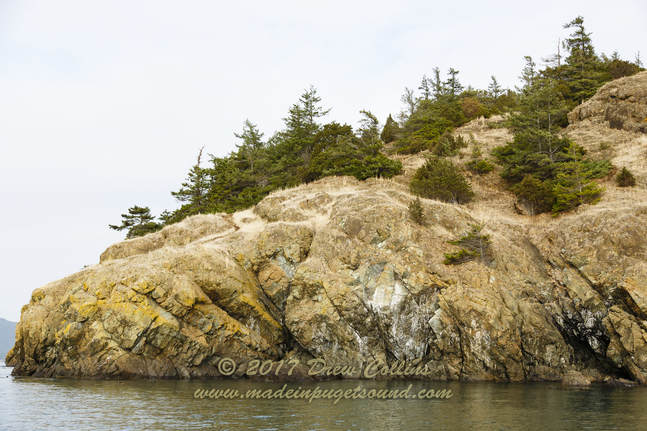
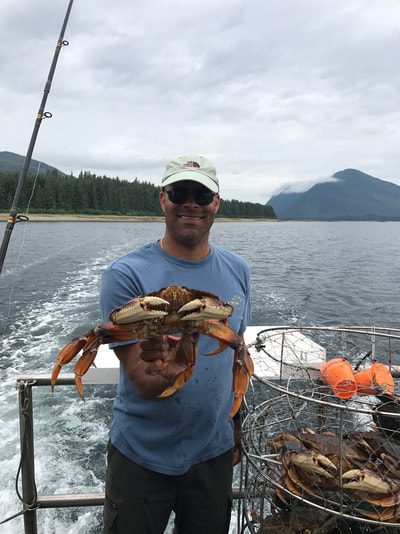
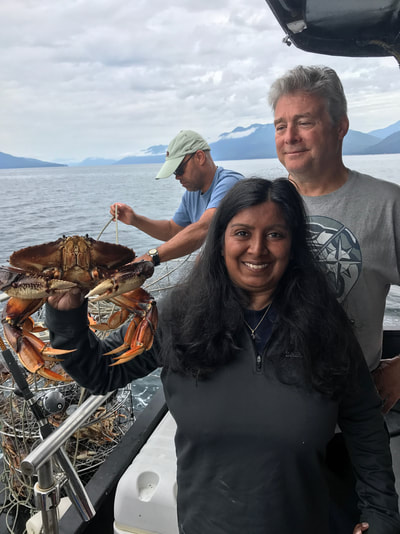
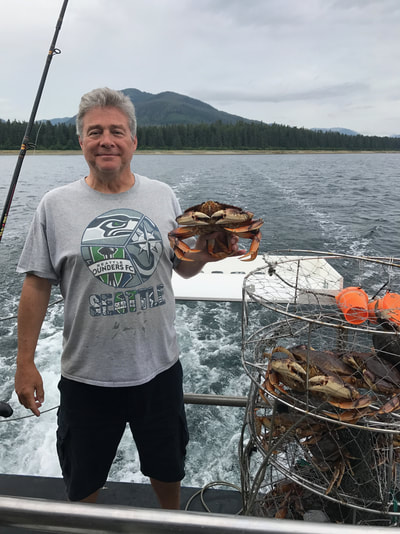
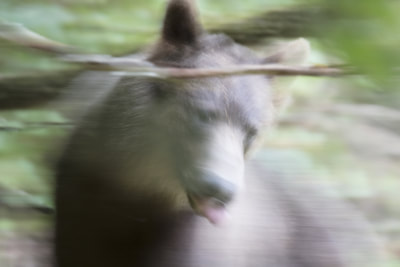
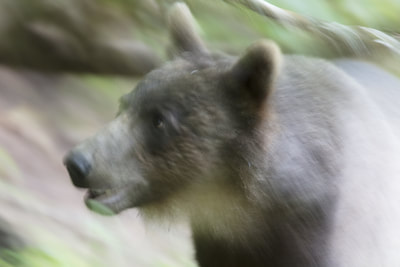
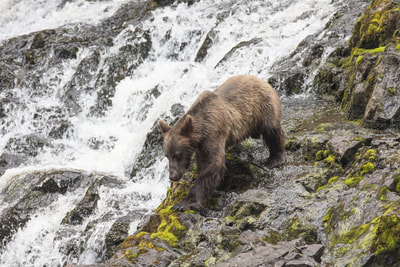
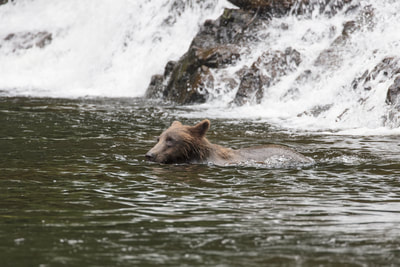
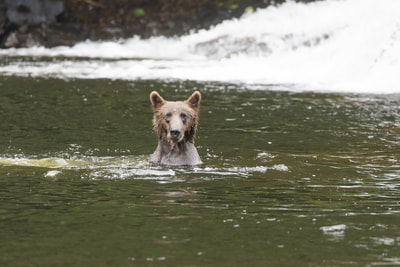
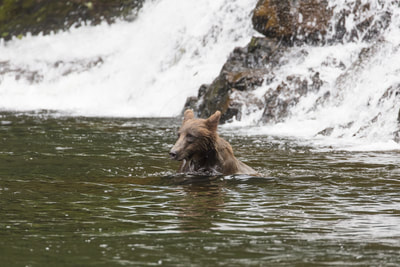
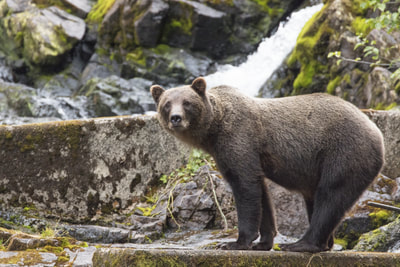
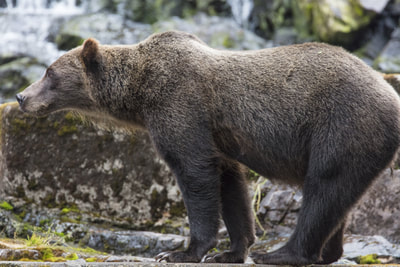
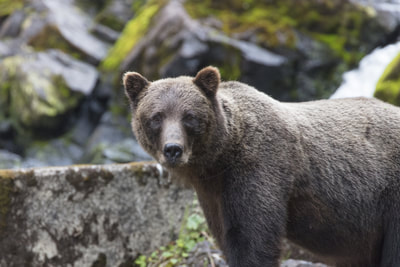
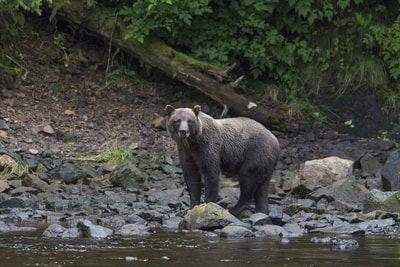
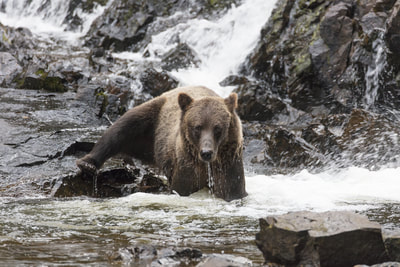
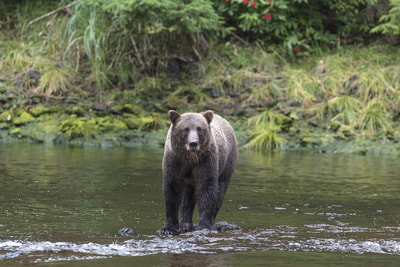
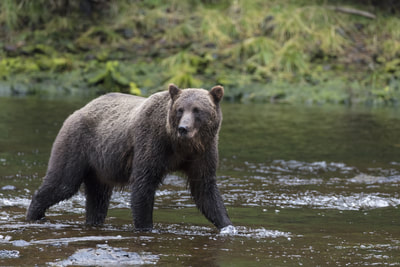
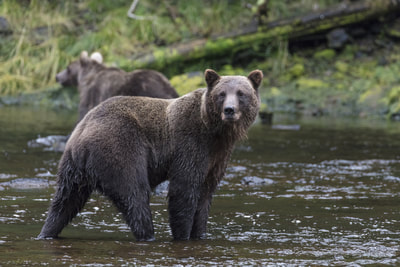
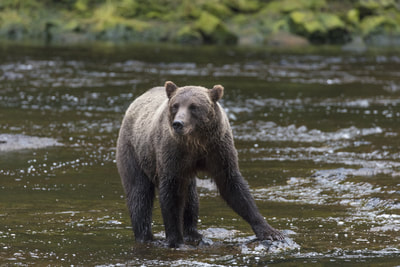
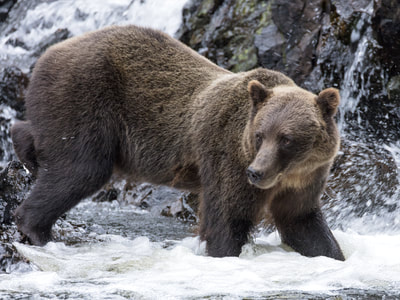
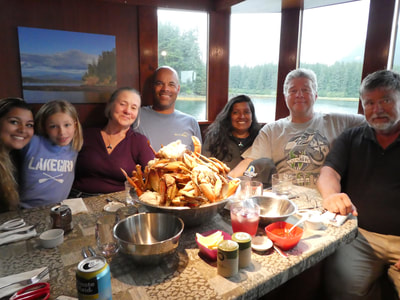
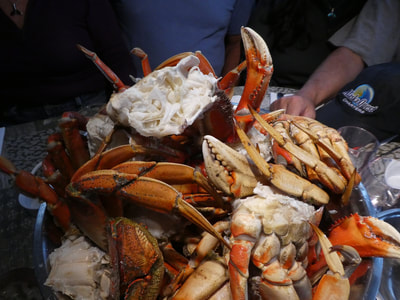
 RSS Feed
RSS Feed